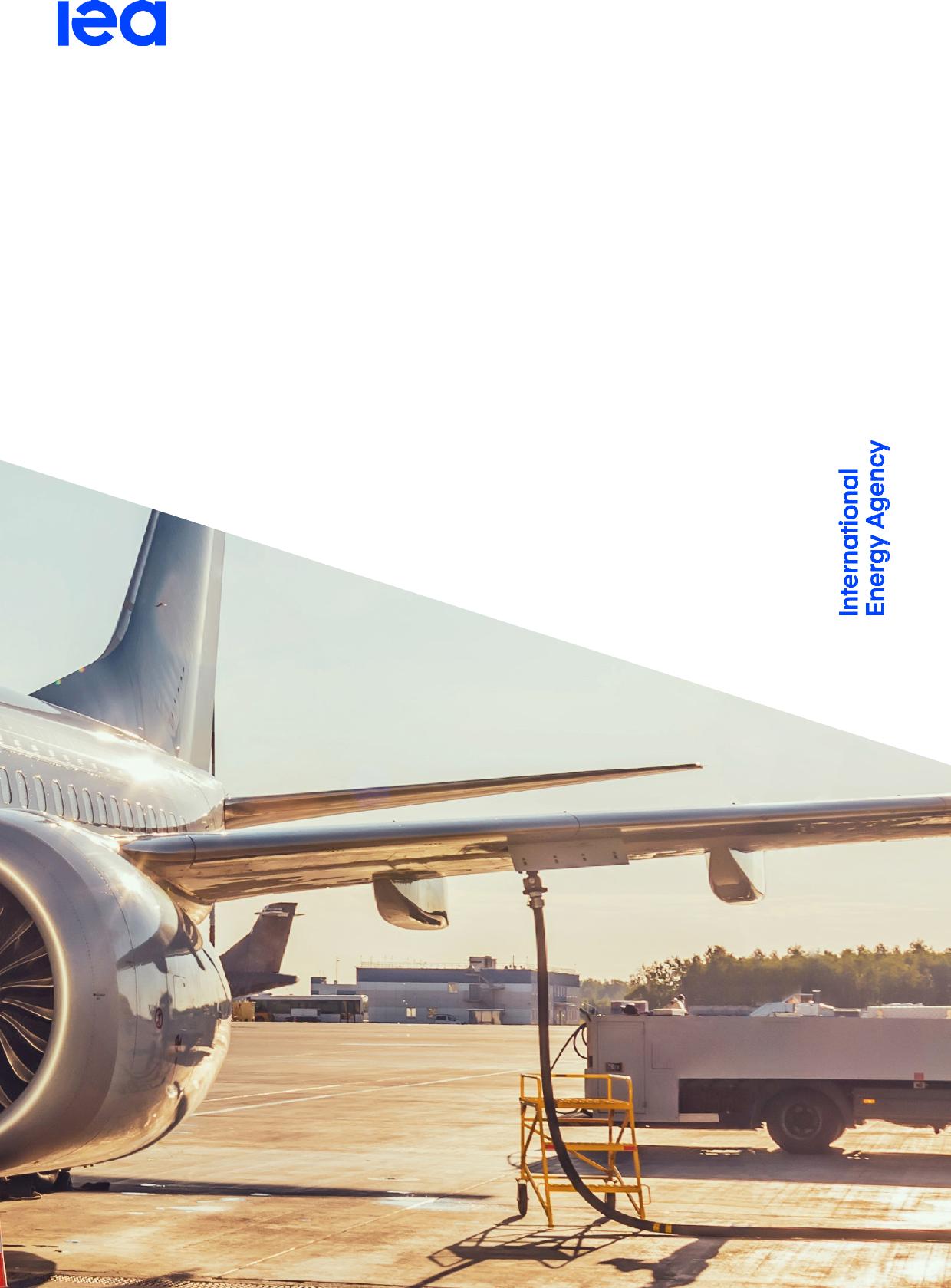TheRoleofE-fuelsinDecarbonisingTransportINTERNATIONALENERGYAGENCYTheIEAexaminestheIEAmemberIEAassociationfullspectrumcountries:countries:ofenergyissuesincludingoil,gasandAustraliaArgentinacoalsupplyandAustriaBrazildemand,renewableBelgiumChinaenergytechnologies,CanadaEgyptelectricitymarkets,CzechRepublicIndiaenergyefficiency,DenmarkIndonesiaaccesstoenergy,EstoniaKenyademandsideFinlandMoroccomanagementandFranceSenegalmuchmore.ThroughGermanySingaporeitswork,theIEAGreeceSouthAfricaadvocatespoliciesthatHungaryThailandwillenhancetheIrelandUkrainereliability,affordabilityItalyandsustainabilityofJapanenergyinitsKorea31membercountries,Lithuania13associationLuxembourgcountriesandbeyond.MexicoNetherlandsThispublicationandanyNewZealandmapincludedhereinareNorwaywithoutprejudicetothePolandstatusoforsovereigntyoverPortugalanyterritory,totheSlovakRepublicdelimitationofinternationalSpainfrontiersandboundariesandSwedentothenameofanyterritory,Switzerlandcityorarea.RepublicofTürkiyeUnitedKingdomUnitedStatesTheEuropeanCommissionalsoparticipatesintheworkoftheIEASource:IEA.InternationalEnergyAgencyWebsite:www.iea.orgTheRoleofE-fuelsinDecarbonisingTransportAbstractAbstractRapiddeploymentoflow-emissionfuelsduringthisdecadewillbecrucialtoacceleratethedecarbonisationofthetransportsector.Significantelectrificationopportunitiesareavailablefortheroadtransportsector,whiletheaviationandmarinesectorscontinuetobemorereliantonfuel-basedsolutionsfortheirdecarbonisation.Fuelsobtainedfromelectrolytichydrogen,ore-fuels,couldbeaviablepathwayandscaleupquicklyby2030,underpinnedbyamassiveexpansionofcheaperrenewableelectricityandanticipatedcostreductionsofelectrolysers.Low-emissione-fuelscanaddtothediversificationofdecarbonisationoptionsthatareavailableforaviationandshippingandthereexistsabigpotentialsynergywithbiofuelsproduction,especiallyintheformofbiogenicCO2utilisation.ThisnewIEAreportpresentsatechno-economicassessmentofafamilyofemerginge-fueltechnologies.Itassessestheimplicationsintermsofneededcostreductions,resourcesandinfrastructureinvestmentsofanassumedambitiousgoalofachievinga10%shareofe-fuelsinaviationandshippingby2030.PAGE3IEA.CCBY4.0.TheRoleofE-fuelsinDecarbonisingTransportAcknowledgementsAcknowledgements,contributorsandcreditsTheRoleofE-fuelsinDecarbonisingTransportreportwaspreparedjointlybytheOilIndustryandMarketsDivisionandtheRenewableEnergyDivisionoftheDirectorateofEnergyMarketsandSecurityoftheInternationalEnergyAgency.ThestudywasdesignedanddirectedbyPaoloFrankl,HeadoftheRenewableEnergyDivision(RED)andTorilBosoni,HeadofOilIndustryandMarketsDivision(OIM),whoalsoco-ordinatedtheproductionofthereport.TheworkbenefittedfromstrategicguidancebyKeisukeSadamori,DirectorofEnergyMarketsandSecurity(EMS).IlkkaHannula,SeniorEnergyAnalyst(RED),ledtheanalysisandwastheprincipalauthorofthereport.OtherauthorswereJoseBermudezMenendez,TorilBosoni,AlexanderBressers,FrancoisBriens,ElizabethConnelly,JoelCouse,LaurenceCret,MathildeFajardy,CiaránHealy,JeremyMoorhouseandYoungsunOm.JenniferThomsonprovidedstatisticalsupportandresearchassistance.DevenMooneesawmyandArielleFrancisprovidedessentialsupport.ValuablecommentsandfeedbackwereprovidedbyseniormanagementandcolleagueswithintheIEA,includingTimurGül,UweRemme,SimonBennett,DavidMartin,RonanGrahamandIliasAtigui.TheIEACommunicationsandDigitalOfficeprovidedproductionsupport.ParticularthanksgotoJethroMullenandhisteam;AstridDumond,OliverJoy,ThereseWalshandClaraVallois.DianeMunroeditedthereport.ManyexpertsfromoutsideoftheIEAprovidedinputandreviewedpreliminarydraftsofthereport.Theircommentsandsuggestionswereofgreatvalue.Theyinclude:AdamBaylin-SternCarbonEngineering(USA)MarcBednarzCWPGlobalHeribBlancoIndependentanalystAngeliqueBrunonTotalEnergiesGabrielCastellanosIMOPierpaoloCazzolaColumbiaUniversityNadiyaDanilina-SchmidtTotalEnergiesArnoDeKlerkUniversityofAlbertaMatthiasDeutschAgoraEnergiewendeMichaelDwyerEnergyInformationAdministrationPAGE4IEA.CCBY4.0.TheRoleofE-fuelsinDecarbonisingTransportAcknowledgementsAnselmEisentrautNesteJacintheFreconAxensThomasGarbeVolkswagenAndresGuzmanValderramaKAPSARCJohnBøgildHansenTopsoeSebastianHirszBPZaffarHussainAgoraEnergiewendeLeandroJankeAgoraEnergiewendeCarolineJungCarbonEngineeringAsmaraKleinTopsoeAndreasKopfITFVittorioManenteAramcoOverseasCompanyB.V.TakehikoNagaiMinistryofEconomy,TradeandIndustry(Japan)UlfNeulingTakashiNomuraAgoraVerkehrswendeTorbenNørgaardToyotaMærskMc-KinneyMøllerCenterforZeroKentaroOeCarbonShippingCédricPhilibertMatteoPrussiPermanentDelegationofJapantotheOECDFrédériqueRigasFrenchInstituteofInternationalRelationsSebastienRochePolitecnicodiTorinoJean-MarcSohierAirbusRobertSpicerTotalEnergiesZoltánSzabóConcaweJacobTeterBPRamVijayagopalEthanolEuropeBojunWangIndependentanalystArgonneNationalLaboratoryIATAPAGE5IEA.CCBY4.0.TheRoleofE-fuelsinDecarbonisingTransportTableofcontentsTableofcontentsExecutivesummary.................................................................................................................7IEA.CCBY4.0.Chapter1.Introduction.........................................................................................................10Chapter2.Decarbonisationtrends.......................................................................................13Transportfueldemand.............................................................................................................13Trackingtransportdecarbonisation..........................................................................................15Biofuelsupplypotential............................................................................................................16Chapter3.Statusandoutlook..............................................................................................20Whataree-fuels?.....................................................................................................................20Currentstatus...........................................................................................................................22Announcedprojects.................................................................................................................22Geographicdistribution............................................................................................................25Policyenvironment...................................................................................................................27Chapter4.Productioncosts..................................................................................................33Plantinvestment.......................................................................................................................33Electricityprice.........................................................................................................................34Captiverenewables..................................................................................................................37CostofCO₂feedstock..............................................................................................................39Heatintegration........................................................................................................................41Innovation.................................................................................................................................43Chapter5.Deploymentanalysis...........................................................................................4610%e-fuelsforaviation............................................................................................................4610%e-fuelsforshipping...........................................................................................................53Chapter6.Resourcerequirements.......................................................................................60Low-emissionelectricity...........................................................................................................60Electrolysercapacity................................................................................................................61CO₂feedstock..........................................................................................................................62Bulkmaterialsandcriticalminerals..........................................................................................63Waterrequirements..................................................................................................................66Landrequirements...................................................................................................................68Expectedleadtimes.................................................................................................................69Chapter7.Policyconsiderations..........................................................................................70Annex....................................................................................................................................73Abbreviationsandacronyms....................................................................................................73Unitsofmeasure......................................................................................................................74PAGE6TheRoleofE-fuelsinDecarbonisingTransportExecutivesummaryExecutivesummaryRapiddeploymentoflow-emissionfuelsduringthisdecadewillbecrucialtoacceleratethedecarbonisationofthetransportsector.Significantreductionsinfossilfueldemandarepossibleinroadtransportthroughfuelefficiencyimprovementsandsurgingsalesofelectricvehicles(EVs).Atthesametime,theaviationandmarinesectorscontinuetobemorereliantonfuel-basedsolutionsfortheirdecarbonisation.Sustainableaviationfuelsareincreasinglybecomingpartoftheaviationfuelmix,whileordersfornewshipsareshowingatrendtowardsalternativefuels.Fuelsobtainedfromelectrolytichydrogen,ore-fuels,couldbeaviablepathwayandscaleuprapidlyby2030,underpinnedbyamassiveexpansionofcheaperrenewableelectricityandanticipatedcostreductionsofelectrolysers.Thisstudyisnotascenarioanalysis,butatechno-economicassessmentofafamilyofemerginge-fueltechnologies.Itassessestheimplicationsintermsofneededcostreductions,resourcesandinfrastructureinvestmentsofanassumedambitiousgoalofachievinga10%shareofe-fuelsinaviationandshippingby2030.Low-emissione-fuelscanaddtothediversificationofdecarbonisationoptionsthatareavailablefortransport.E-fuelsarelow-emissionfuelswhentheirhydrogenisproducedusinglow-emissionelectricityandanycarboninputsareobtainedinawaythatleadstolowlife-cyclegreenhousegasemissions.Intransport,low-emissione-fuelsprovideacomplementarysolutiontosustainablebiofuels.Particularlyinaviation,e-fuelsbenefitfromtheirabilitytouseexistingtransport,storage,distributioninfrastructureandend-useequipment.Low-emissione-fuelsarecurrentlyexpensivetoproduce,buttheircostgapwithfossilfuelscouldbesignificantlyreducedby2030.Bytheendofthedecade,drivenbycostreductionsenabledbytherealisationofcurrentgloballyannouncedelectrolyserprojects,tappingsiteswithhigh-qualityrenewableresourcesandoptimisedprojectdesign,thecostoflow-emissione-kerosenecouldbereducedtoUSD50/GJ(USD2150/t),whichwouldenableittocompetewithbiomass-basedsustainableaviationfuels.Thecostoflow-emissione-methanolcouldbecuttoUSD35/GJ(USD700/t)ande-ammoniatoUSD30/GJ(USD550/t)makingthemcostcomparablewiththehigherendoffossilmethanolandammoniapricesoverthe2010-2020periodasachemicalcommodity,andopeningadoorfortheiruseasalow-emissionfuelsforshipping.Moreover,theproductionofe-fuelsforaviationalsoleadstonon-negligibleamountofe-gasolinebeingproducedasaby-product.PAGE7IEA.CCBY4.0.TheRoleofE-fuelsinDecarbonisingTransportExecutivesummaryLow-emissione-fuels,whilestillcostlyin2030,willhavelimitedimpactontransportpricesata10%share.AtacostofUSD50/GJ,e-kerosenewouldincreasetheticketpriceofaflightusing10%ofe-fuelsbyjust5%.Althoughe-methanolande-ammoniaarecheapertoproducethane-kerosene,theirwidespreaduseasshippingfuelswillrequiresignificantinvestmentsincompatiblebunkeringinfrastructureandships.Thetotalcostofownershipofa100%e-ammoniaore-methanol-fuelledcontainershipwouldbe75%higherthanaconventionalcontainershipoperatingonfossilfuels.Althoughasubstantialincrease,theextracostwouldrepresentonly1-2%ofthetypicalvalueofgoodstransportedincontainers.Duetoseveralconversionstepsandassociatedlosses,theproductionofe-fuelsgenerallysuffersfromlowefficiency,leadingtohighresourceand/orinfrastructuredemand.Producinglargeamountsoflow-emissione-fuelscouldtriggeraround2000TWh/yrofadditionalrenewableelectricitydemandby2030.Whileasignificantincrease,thatwouldbearoundone-fifthofthegrowthoflow-emissionelectricityduringthisdecadeintheIEA’sStatedPoliciesScenario(STEPS),andlessintheAnnouncedPledgesScenario(APS)andNetZeroEmissionsby2050Scenario(NZEScenario).Theproductionoflow-emissione-fuelscanalsounlockthehugepotentialofremotelocationswithhigh-qualityrenewableresourcesandvastamountsoflandavailableforlarge-scaleprojectdevelopment,whichwouldnototherwisehavehighelectricitydemand.Bycontrast,asignificantrampupofelectrolysermanufacturingwouldbeneededtoachievea10%shareofe-fuelsinbothaviationandshippingsinceitwouldrequireover400GWofelectrolysercapacity,equaltotheentiresizeoftheglobalelectrolyserprojectpipelineto2030.Accelerateddeploymentoflow-emissione-fuelsforshippingwouldrequiresignificantinvestmentsinrefuellinginfrastructureandinvessels.Achievinga10%shareinshippingwouldrequirearound70Mt/yrofe-ammoniaore-methanol.Thisis3.5timesthecurrentglobaltradedvolumeofammoniaortwotimesthetradeinmethanol.AdditionalcumulativeinvestmentsinshippingcapacitywouldbeUSD30-75billion,dependentonhowinvestmentswouldbedistributedbetweenammoniaandmethanolships.Thiswouldrepresentlessthana5%shareofthecumulativeshipbuildingmarketsizeovertheperiodof2023-2030.Similarly,theincrementalinvestmentforbunkeringinfrastructureisexpectedtobeintheorderofUSD10-30billion.Carbon-containinglow-emissione-keroseneande-methanolwouldrequireamassiveincreaseinCO₂utilisation.Thereexistsasignificantpotentialsynergywithbiofuelsproduction,asby-productCO2frombioethanolandfrombiomethaneplantsareamongthecheapest(USD20-30/tCO2)sources.Moreover,comingfromsustainablebiogenicsources,theyenabletheproductionoflowlife-cycleGHGemissione-fuels.PAGE8IEA.CCBY4.0.TheRoleofE-fuelsinDecarbonisingTransportExecutivesummaryAround200MtCO₂wouldbeneededtoproducethe10%shareofe-keroseneforaviation,and150MtCO₂toproducethe10%shareforshippingifallwouldbeintheformofe-methanol.Itwouldnotbepossibletosupplythiscombinedamountfromlow-costbiogenicsourcesalone,butitcouldbesupplementedfrompulpmaking,albeitatahighercost.Inanycase,utilisingthiscurrentlyuntappedresourcewouldrequiremassivescaleupofover100timesthecurrentcapturevolumesfrombiogenicsources.AccesstoCO₂isanimportantconstrainttocarbon-containinglow-emissione-fuels,whichisnotthecasewithe-ammonia.Thebestwindandsolarresourcesarenotnecessarilyco-locatedwithsignificantbioenergyresources,whichputsadditionalconstraintsonsitinge-fuelprojectsthatrequirecarboninput.ThismayrequireCO2pipelineinfrastructure.Whiletechno-economicallyfeasible,itmayfaceimportantsocialacceptancechallenges.Directaircapture(DAC)ofCO₂couldprovideapotentiallyunlimitedsourceofCO₂feedstockwithoutgeographicconstraints,butitisexpectedtoremainahigh-costoptionin2030.Bycontrast,asacarbon-freemolecule,ammoniaproductiondoesnotrequireCO2,thereforehaslessconstraintsforprojectdevelopment.Toenablewidespreadadoptionandtrade,e-fuelswillneedtomeetestablishedtechnicalandsafetystandardsandinternationallyagreedmethodologiesformeasuringlife-cycleGHGemissions.InternationalbodiessuchasInternationalOrganizationforStandardization(ISO),theInternationalMaritimeOrganization(IMO)andtheAmericanSocietyforTestingandMaterials(ASTM)havealreadyestablishedstandardsforsomee-fuelproductionandusepathways,butstandardsforammoniaqualityandsafety,methanolsafety,andhighere-keroseneblendinglevelsarestillunderdevelopment.Furtherdevelopmentofcomprehensiveinternationalstandards,protocolsandpathwaysforfuelquality,safetyandlife-cycleGHGemissionsareneededtoenabletradeanduseininternationalaviationandshipping.Theseprocesseswillalsorequireongoingdevelopmentasnewtechnologiesandapplicationsfore-fuelsevolve.Governmentsneedtotakebolderactiontostimulatedemandforlow-emissione-fuels.Inordertoexploitpotentialdecarbonisationoptions,withlimitedincreaseonconsumerprices,achievingeconomiesofscalethroughpredictabledemandwillbekey.Morethan200projectsarecurrentlyunderdevelopmentaroundtheworld,althoughalargemajorityofe-fuelprojectsareatearlystages.Toachieveaccelerateddeployment,itisessentialthatcountriescontinuetoadoptpoliciesthatcreateapredictabledemandforearlyprojects,supportrequiredinfrastructureinvestments,drivedownthecostofelectrolysers,encourageR&Dactivitiesfocusedondevelopingnewhigh-efficiencye-fueltechnologies,andpromotethepotentialtoexploitsynergiesbetweene-fuels,biofuelsandcarboncaptureutilisationandstorage(CCUS).PAGE9IEA.CCBY4.0.TheRoleofE-fuelsinDecarbonisingTransportChapter1.IntroductionChapter1.IntroductionTheglobalenergycrisishasmovedenergysecuritytotheforeoftheinternationalpolicyagendaandacceleratedthemomentumbehindthedeploymentofcleanenergytechnologies.Governmentpolicymakersprioritisingenergysecurityareincreasinglyfocusedontherolethatfuelsobtainedfromelectrolytichydrogen,ore-fuels,canplayinreducingoildependenceanddecarbonisingthetransportsector.E-fuelsarelow-emissionfuelswhentheirhydrogenisproducedusinglow-emissionelectricityandanycarboninputsareobtainedinawaythatleadstolowlife-cyclegreenhousegasemissions.E-fuelsmadefrombiogenicorair-capturedCO₂canpotentiallyprovidefullemissionsreduction,makingthemtheprimaryproductionpathwaythatisconsistentwithachievingnetzeroemissionsbymid-century.Investmentincleanenergyisalreadyacceleratingatamuchfasterratethanforfossilfuels,helpingtodeliverapeakinglobalfossilfuelusebefore2030.From2017to2023,cleanenergyinvestmentsincreasedfromaroundUSD1.13trilliontoUSD1.74trillion.Atthesametime,spendingonfossilfuelsdeclinedfromUSD1.11trilliontoUSD1.05trillion.However,thepaceofchangeisstilltooslow,andstrongerpolicymeasuresandbehaviouralchangeswillbeneededtogetontrackwiththeNZEScenario.Figure1.1TransportsectoroildemandundercurrentpoliciesandnetzerotargetsRoadTransportAviationShipping1001814901680EJ1412701260IEA.CCBY4.0.1010504088306204610200420182018220222026203020222026203002022202620302018OIL2023NZEIEA.CCBY4.0.Notes:Oil2023=datafromtheIEA’sOil2023-Analysisandforecastto2028.NZE=NetZeroEmissionsby2050Scenario.Inroadtransport,vehicleefficiencyimprovements–alongwithsurgingsalesofhybridandelectricvehicles–aredrivingdownaveragefuelconsumptionandCO₂PAGE10userid:246491,docid:149863,date:2023-12-27,sgpjbg.comTheRoleofE-fuelsinDecarbonisingTransportChapter1.Introductionemissions.Asaresult,gasolineanddieselusebycars,vans,trucksandbusesissettopeakthisdecadedespitetheprojectedsurgeinthenumberofvehiclesontheroadsby2030,especiallyinemerginganddevelopingcountries.Atthesametime,aviationdemandissettonearlydoublefrom3.5trillionpassengerkilometres(pkm)in2022to6.7trillionpkmin2030(9%CAGR).Shippingdemandsimilarlyrisesfrom124trilliontonnekilometres(tkm)to145trilliontkm(2%CAGR)overthesameperiod,accordingtotheIEA’srecentlyupdatedNetZeroRoadmap.Againstthebackdropofincreasingtransportdemand,sustainablefuelswillplayacriticalroleindecarbonisingtheaviationandshippingsectors.Evenasbatteriesandelectricmotorsbecomeviableinaviationandmaritimeapplications,theyarelikelytobelimitedtosmalleraircraftandvesselswithshortertransitranges,givenlimitationsinbatteryenergyandpowerdensity.Sustainableaviationfuelsareincreasinglybecomingpartoftheaviationfuelmix,whileordersfornewshipsareshowingatrendtowardsalternativefuels.Whene-keroseneisproducedtocomplementsustainablebiofuelsinaviation,anon-negligibleamountofe-gasolineisproducedasaby-product.Itcouldbeblendedintothemotorgasolinepoolorusedforpetrochemicals.Theproductionofe-dieselisalsopossible.Thedrop-innatureofsomee-fuelsmeansthat,alongsidebiofuels,theycouldhelpreduceemissionsfromthecurrentvehiclestockandspeedupthedecarbonisationofroadtransportwithonlylimitedornoinvestmentsindistributionandend-useinfrastructure.Itcouldalsohelpalleviateconcernsoverthesecurityofsupplyofcriticalmineralsneededforbatterymanufacturing.Despitelimiteddeploymenttoday,thenumberofannouncedlow-emissione-fuelsprojectsisincreasingatarapidrate.Morethan200projectsarecurrentlyunderdevelopmentaroundtheworld,butthemajorityofthemarestillinearlystages.Theslowuptakeoflow-emissione-fuelsisaconsequenceofawidecostgapwithincumbentfossilfuelsandotheralreadycommerciallyavailablelow-emissionalternatives,suchasbiofuels.Iflow-emissione-fuelsaretomakeameaningfulcontributiontoemissionsreductionsinenergytransitions,arapidscaleupisneededduringthisdecade.Thisstudyisnotascenarioanalysis,butatechno-economicassessmentofafamilyofemerginge-fueltechnologies.Itassessestheimplicationsintermsofneededcostreductions,resourcesandinfrastructureinvestmentsofanassumedambitiousgoalofachievinga10%shareofe-fuelsinaviationandshippingby2030.Chapter2providesanoverviewofthedemandtrendsintransportanddiscussesthesupplypotentialofbiofuels.Chapter3reviewsthecurrentstatusofe-fueltechnologiesandprovidesanoutlookto2030basedonannouncedprojects.Italsoreviewsthepolicyenvironmentrelevantforlow-emissione-fuelsPAGE11IEA.CCBY4.0.TheRoleofE-fuelsinDecarbonisingTransportChapter1.Introductiondevelopment.Withthehighcostofe-fuelscurrentlythelargestimpedimenttotheirdeployment,Chapter4focusesonfactorsthatcontributetothesteepcostofe-fuelsandonopportunitiesforreducingthemby2030.Chapter5analysestheimpactsofanaccelerateddeploymentoflow-emissione-fuelsforaviationandshippingduringthisdecade,whileChapter6outlinestheresourceneedsassociatedwithsuchdeployment.Finally,Chapter7discussespolicyimplicationsoftheanalysisandoutlinespossiblenextstepstoenableanaccelerateddeployment.PAGE12IEA.CCBY4.0.TheRoleofE-fuelsinDecarbonisingTransportChapter2.DecarbonisationtrendsChapter2.DecarbonisationtrendsTransportfueldemandGlobaloildemandisforecasttopeakthisdecadeasenergytransitionsgatherpaceandtransportfueldemandgrowthslows.Ledbycontinuedincreasesinairtravelandpetrochemicalfeedstockuptake,totaloilconsumption(excludingbiofuels)isneverthelessforecasttoriseto102mb/dby2030,5mb/dabove2022levels.Someeconomies,notablythePeople’sRepublicofChina(hereafter,“China”)andIndia,willcontinuetoregistergrowththroughouttheforecast.Bycontrast,oildemandinadvancedeconomiesmayreachapeakthisyear–aresultofthesweepingimpactofimprovementsinvehicleefficienciesandelectrification.Figure2.1Annualoildemandgrowth,2022-20302.5mb/d2.0TotaloilIEA.CCBY4.0.Roadtransport1.5OthertransportOtheroil1.0IEA.CCBY4.0.0.50.0-0.5-1.0202320242025202620272028202920302022Note:Othertransportdemandincludesaviation,marineandrail.Source:IEA(2023),Oil2023–Analysisandforecastto2028,extendedthrough2030.Oildemandusedasatransportfuelissettodeclinefrom2026duetoefficiencyimprovementsandarapiduptakeofhybridandEVsandincreasedbiofuelsuse.Thepaceofchangevariesacrossdifferenttransportmodesanddependsonthepotentialfordirectelectrification.Globalroadtransportfueldemand,accountingfornearlyhalfoftotaloilconsumption,isforecasttodecreasefrom2024.TheproliferationofvehicleefficiencyimprovementsalongwithsurgingsalesofhybridandelectricvehiclesaredrivingdownaveragefuelconsumptionandCO₂emissionsfromtheroadtransportsector.In2023,nearlyoneinfivecarssoldwereelectric,anincreaseofroughly35%fromtheyearbefore.IfthepaceofgrowthinEVsalesoverthePAGE13TheRoleofE-fuelsinDecarbonisingTransportChapter2.Decarbonisationtrendspasttwoyearsissustainedthrough2030,CO₂emissionsfromcarscanbeputonapathinlinetheNZEScenario.Projectedoilconsumptionfor2030wouldbe7.5mb/dhigherwithoutthesavingsfromnewEVsandefficiencyimprovementssince2022,andafurther0.5mb/dwithoutadditionalbiofuelsproduction.Post-pandemicchangesinconsumerbehaviourprovideadditionaldemandreductions,ashybridworkingandvideoconferencinghavebecomeestablishedforsomebusinesssectorsinadvancedeconomies.Figure2.2ImpactofEVsandefficienciesontotaltransportoildemand,2022-203070mb/d65605550202220232024202520262027202820292030TotaltransportdemandAdditionalbiofuelsEfficiencysavingsEVsavingsIEA.CCBY4.0.Source:IEA(2023),Oil2023–Analysisandforecastto2028.Bycontrast,globalairtrafficisexpectedtocompleteitssharppost-Covidreboundbeforetheendof2024.Thereafter,structurallyincreasingdemandforlong-distancetravel,stronglyassociatedwithhigherGDPinmiddle-incomecountries,willremainapillarofoverallgrowth.Totaljetfueldemandwillriseby2mb/dbetween2022and2030,butasubstantialimprovementinaircraftfuelefficienciesmeansthatitwilltakeuntil2027toexceed2019levels.Whileglobalairtraffichadrecoveredtovirtuallymatchpre-pandemicactivitybytheendof2023,overalljet/kerosenedemandremained7%lower.Thisreflectssubstantialchangesinfleetcompositionsince2019,withneweraircrafttypicallyusing20-30%lessfuelthanthemodelsbeingreplaced.Oilusedformarinebunkersisexpectedtoincreasebyafurther300kb/dthrough2030,inlinewithgrowthineconomicactivityandtrade.Efficiencygains,spurredbyprogressivelytightermeasurestoreducegreenhousegasemissions,willneverthelesstemperdemandgrowth.Tofurtherreduceroadtransportandairtravel,expansionofhigh-speedrailnetworksshouldbeimplemented.Whilerailiscurrentlytheleastemissions-intensivemodeofpassengertransport,furtherelectrificationofdieseloperationsPAGE14IEA.CCBY4.0.TheRoleofE-fuelsinDecarbonisingTransportChapter2.Decarbonisationtrendswhereverviable,aswellastheuseofbiodieselblendsorhydrogen,wouldbeneededtogetontrackwiththeNZEScenario.TrackingtransportdecarbonisationAviationFrom2010to2019,averagefuelefficiencyperrevenuetonnekilometre(rtk)equivalenttravelledimprovedby1.8%peryearthankstotheintroductionofmoreefficientaircraftandengines,withgainsoverthedecadenearlyreachingtheUN’sInternationalCivilAviationOrganization’s(ICAO)aspirationalgoalof2%perannumthrough2050.Inadditiontotechnicalefficiencyadvancesinengineandairframedesigns,improvementsinpayloadandtrafficefficiency(i.e.theweightofcargoandnumberofpassengerscarriedperaircraft)havealsocontributedtoreducingtheenergyintensityofaircraftoperation.However,efficiencygainshavenotkeptupwithdemandgrowth,whichroseatanaveragerateofover5%annuallybetween2010and2019.FurtherefficiencyprogresswasmadeduringtheCovid-19pandemic,whenanumberofaircraftwereretiredandreplacedbynewermodelstypicallyusing20-30%lessfuel.Currently,demandforaviationfuelisdominatedbyjetkerosene,whilesustainableaviationfuel(SAF)accountsforlessthan0.1%ofallfuelsconsumed.ManufacturersandoperatorsareincreasinglytestingflightsthatareentirelyfuelledbySAF,whichcanbedeployedincurrentinfrastructure,enginesandaircraftwithminoradjustmentstofueldeliveryequipment.However,plannedproductioncapacitieswillprovidejust1-2%ofjetfueldemandby2027.InternationalshippingTheenergyefficiencyofshipsisregulatedbytheInternationalConventionforthePreventionofPollutionfromShips(MARPOL),AnnexVI.Fornewships,theEnergyEfficiencyDesignIndex(EEDI)needstomeetcriteriathatgetmorestringentovertime,uptoareductionofemissionsperunitofactivityof30%by2025comparedto2000-2010levels.Similarly,existingshipsarecoveredbytheEnergyEfficiencyExistingShipIndex(EEXI).Inaddition,fromJanuary2023,theCarbonIntensityIndicator(CII)regulatestheoperationofshipswithincreasinglystringentrequirements.Ithasbeenestimatedthatnearlythree-quartersofnewlybuiltcontainershipsandgeneralcargoshipsalreadymeetthepost-2025EEDIrequirements,withenergysavingsofmorethan50%.Whilelow-emissionfuelsaregoingtoplayanincreasingroleinthemarinesector,technologicaldevelopmentandincreasedpolicysupportwillbeneededtoreducedependencyonfossilfuelsininternationalshipping.Thisparticularlyconcernsbunkerfueltransporttoseaports,bunkeringinfrastructureandprotocols,onboardstoragePAGE15IEA.CCBY4.0.TheRoleofE-fuelsinDecarbonisingTransportChapter2.Decarbonisationtrendstanks,fueldeliverysystems,enginesandemissionsafter-treatmentand,crucially,trainingandsafetyintheuseofthenewfuels.Slowstockturnoverisduetothelongvessellifetimes,ataround30yearsonaveragebutvaryingfrom25yearsforcontainershipstoasmuchas35yearsforgeneralcargovessels.Thecurrentaverageageofcontainershipsinserviceisaround14years,12yearsforbulkcarriersand20yearsforoiltankers,accordingtoUNCTAD.Thosethreeshiptypestakentogethermakeuptwo-thirdsofinternationalshippingemissions,accordingtotheIMO.Thismeansnear-terminnovation,optimisationofshipdesigntoallowforeasyretrofitting,andzero-emissiontechnologyadoptionarecriticaltoputtinginternationalshippingonanambitiousemissionsreductiontrack.RoadtransportPrivatecarsandvanswereresponsibleformorethan25%ofglobaloiluseandaround10%ofglobalenergy-relatedCO₂emissionsin2022.Emissionsfromlight-dutyvehicles(LDVs)willneedtofallbyaround6%eachyearthrough2030togetontrackwiththeNZEScenario.EVsarethekeytechnologytodecarboniseroadtransport.PassengerEVssalessurgedbyaround55%in2022and35%in2023,tomorethan18%ofallnewcarssold.IfthelevelofgrowthinEVsalespostedoverthepasttwoyearsissustaineduntil2030,CO₂emissionsfromcarswouldalignwithapathwaytowardstheNZEScenario.However,electricvehiclesarenotyetaglobalphenomenon.OutsideofChina,salesindevelopingandemergingeconomieshavebeenslowtopickupduetotherelativelyhighpurchasepriceofanEVandlackofcharginginfrastructure.CO₂emissionsfromheavy-dutyvehicles(HDVs),includingtrucksandbuses,needtopeakrapidlyandstartdeclininginthecomingdecadetoreachNZEScenariomilestones.HDVfueleconomystandardsandzero-emissionvehiclemandatesneedtobeadopted,andthosethatexiststrengthenedandharmonisedtodecarbonisethesectorinparallelwithpoliciesthatenablethesupportingEVcharginginfrastructure.Electricandhydrogenfuel-cellHDVsneedtobedeployednowtoenableemissionsreductionsinthe2020sand2030s.AligningwiththeNZEScenariowillrequireadropinemissionsof15%by2030relativetotheircurrentlevel,decliningatroughly2%peryear.BiofuelsupplypotentialLiquidbiofuelsplayacriticalroleindecarbonisingtransportbecausetheycanreduceemissionsinhardtoabatesectorssuchshipping,aviationandlong-haultrucking,andarecompatiblewithexistinginfrastructure.However,theavailabilityofsustainablefeedstockwilllimitsupplyfromcurrenttechnologies.Biofuelproductionin2022stoodat4.3EJ,representingnearly4%ofglobalroadtransportPAGE16IEA.CCBY4.0.TheRoleofE-fuelsinDecarbonisingTransportChapter2.Decarbonisationtrendsfueldemand.Thevastmajority,about90%,ofthesefuelswereproducedfromsugarcane,corn,soybeanoil,rapeseedoilandpalmoil.Theremaining10%wasproducedfromwasteandresiduefeedstockssuchasusedcookingoilandanimalfats.Biofueldemandisforecasttoexpandto5.3EJ,representing6%offorecastedroadtransportenergydemandin2030,drivenbypoliciesandplannedprojectadditions.Roadtransportaccountedfornearlyallliquidbiofuelsusein2022,anditssharedeclinesonlyslightlyto98%by2030.1Figure2.3Liquidbiofuelannualsupplypotentialbyfeedstocktypeandtechnologyreadinesslevel,2022-203060Otherorganicfeedstocks(agriculturalandforestrySupplypotential(EJ)residues,municipalsolidwaste,shortrotationwoodyIEA.CCBY4.0.50cropsandforestryplantations)New,compatiblefeedstocks(e.g.grownonmarginalland,orascovercrops)40Wasteandresidueoils(usedcookingoil,animalfatsandotherresidueoils)30Sustainablecroppotential(intensificationofcurrentcropssuchascorn,sugarandsoyoil)20Forecastgrowth2022-3010Production20220TR-9to10TR-4to8IEA.CCBY4.0.Notes:TheIEA’sTRLscaleaimstocoverallrelevantstepsoftheinnovationjourney,fromconcepttomarketmaturity,andmaydifferfromthescaleusedbyotherresearchinstitutes.Totalsupplypotentialassumesall100EJoftheIEA’sestimatedsustainablebioenergysupplywereconvertedtoliquidfuels.Totalliquidfuelsupplyisnear60EJwhenaccountingforconversionlosses.Sources:ExistingandforecastgrowthfromIEA(2022),Renewables2022,sustainablecroppotentialandotherorganicfeedstocksfromIEA(2022),WorldEnergyOutlook2022,wasteandresiduepotentialandnew,compatiblefeedstocksfromtheWorldEconomicForum’sCleanSkiesforTomorrowCoalition.TRLsfromIEA(2023),ETPCleanEnergyTechnologyGuide.Thosefeedstocksmostreadilyavailableforliquidbiofuelsincludevegetableoils,sugars,starchesandincreasedcollectionofresiduesfats,oilsandgreases.Allthesefeedstocksarealreadyusedtodayandcanbeprocessedusingcommercialtechnologies.However,suppliesofthistypearerelativelylimited,andcouldlikelyoffsetanadditional3%oftransportfueldemandby2030,beyondexistingandforecastbiofuelproduction.Insomemarkets,suchastheEuropeanUnion,thesefeedstockshavealreadybeencappedintransportpoliciesbecauseofsustainabilityconcerns.Globally,feedstocksuppliesofthistypewouldbringtotalliquidbiofuelsupplypotentialto9EJby2030atproductioncostsbetween1ForecastbiofuelproductionvaluesarebasedonthemaincaseintheRenewableEnergyMarketUpdate–June2023andextendedto2030from2028usingtheglobalproductiongrowthtrendfrom2022to2028.PAGE17TheRoleofE-fuelsinDecarbonisingTransportChapter2.DecarbonisationtrendsUSD25/GJtoUSD50/GJforroadtransport(USD15-25/GJforfossilfuelgasolineanddiesel),andUSD60/GJforaviation(USD20/GJforfossilfueljetfuel).Expandingbiofuelsbeyond9EJwouldrequireotherfeedstocksthatareavailableinlargerquantitiesanddonotcompeteforlandresourcesforfoodandfeedproduction.Theseincludenewfeedstockscompatiblewithexistingtechnologiesthatcanbegrownonmarginallandorascovercrops.Currentestimatesstandatnear8EJofliquidbiofuelpotential.However,thesegrowingtechniqueshavenotbeenwidelyadoptedforbiofuelproduction,comeathighercosts,requirestrictsustainabilitycriteriaanddedicatedpolicysupport,andtheremayalsobecompetitionforotherbioenergyuses.Otherorganicfeedstockssuchasagriculturalandforestryresidues,aswellasmunicipalsolidwaste,offeradditionalsupplypotentialbutarenotyetbeingdeployedatscaleandcompetewithotherbioenergyuses.Theopportunityforexpansionissubstantial,withanestimated40EJofliquidbiofuelpotential.However,realisingthispotentialdependsonprocessingwoodyandfibrousresiduesusingtechnologieslikecellulosicethanolandbiomassgasification.Considerableinvestmentsinthesetechnologiesandsupplychainswillberequiredtocommercialiseanddeployatscale.Althoughspendingonthesetechnologiesisacceleratingglobally,includingcommercialscaleprojects,thetotalforecastproductionremainssmall.Globally,biofuelprojectsthataimtousenewandcompatiblefeedstocksandwoodyresiduesareprojectedtocontributeonly0.2EJofadditionalsupplyby2030,amere4%oftheglobalbiofuelproduction.Inaddition,thereiscompetitionforotherorganicfeedstocksforbiogasproduction,assolidbioenergyforheatandpowerapplications,soliquidbiofuelswouldonlygarnerashareofthispotential.Thatsharewilldependonmandates,costsandtherelativevalueofthefeedstocksinproducingdifferentformsofenergy.Insomeinstances,technologycanalsobeusedtoshiftfeedstocksfromonebiofuelproducttoanother.Forexample,ethanolaccountsforhalfofbiofuelproductiontodayandisusedingasolinevehicles.AsvehicleefficiencyandEVsstarttoreducemotorgasolinedemandto2030,asurplusofethanolproductioncoulddevelopifethanolblendratesremainlowandblendingmandatesdonotincrease.Alcohol-to-jetoffersawaytoconvertethanolintosustainableaviationfuel.Hydroprocessedestersandfattyacids(HEFA)facilitiescanalsobebuiltandoperatedorretrofittedtovaryrenewablediesel/bio-jetproductionusingthesamefeedstocks.Biofuelsholdconsiderablepromiseforreducinggreenhousegasemissionsinthetransportsector,buttheyarelikelytobecomplementedbyothereffortssuchaslow-emissione-fuels.Moreover,muchoftheexistingandplannedbiofuelsproductionisdedicatedtoroadtransportthrough2030.Expandingbiofuelproductionforroad,aviationandmarineconsistentwithanetzeropathwaywouldPAGE18IEA.CCBY4.0.TheRoleofE-fuelsinDecarbonisingTransportChapter2.Decarbonisationtrendsrequirenear6EJofadditionalsupply,whichwouldrequirealloftheIEA’sestimatedsustainablesupplyfromagricultureandresiduefats,oilsandgreasescommonlyusedtoday,plussignificantinvestmentinnewagriculturalpracticesandtechnologiestoaccessmoreofthereadilyavailablefeedstocks.Stringentsupplyanddemandpolicieswithstrictsustainabilitycriteriawouldalsobeneededtodriveinvestmentandensuresustainablefeedstockuse.PAGE19IEA.CCBY4.0.TheRoleofE-fuelsinDecarbonisingTransportChapter3.StatusandoutlookChapter3.StatusandoutlookWhataree-fuels?E-fuelsarefuelsobtainedfromelectrolytichydrogen.E-fuelsarelow-emissionfuelswhentheirhydrogenisproducedusinglow-emissionelectricityandanycarboninputsareobtainedinawaythatleadstolowlife-cyclegreenhousegasemissions.Variousdifferentfueltypescanbeproducedalongthisbasicroute.Thecombinationofhydrogenwithnitrogenproducesammonia,agaseouschemicalthatisusedtodaymainlyasaprecursortofertilisers,butthatalsohasapplicationasafuel.Thecombinationwithcarbonopensthepossibilitytoproduceawiderangeofproducts,fromalcoholstoethersandfromhydrocarbonfuelstolubricants.Differentfuelproductscanbefurthercategorisedbytheireaseofuse.Drop-ine-fuelssuchase-kerosene,e-dieselande-gasolinearecompatiblewithexistingrefuellinginfrastructureandcanbeblendedwithlimitedconstraintswithpetroleum-derivedcounterparts.Bycontrast,alternativee-fuelssuchase-ammoniaande-methanolrequireinvestmentsindistributioninfrastructureandend-useequipmenttoenabletheiruseinthetransportsector.Figure3.1E-fuelsandproductionroutesconsideredinthisreportHydrogenfromHydrogenfromfossilelectrolysisfuelswithCCUSHydrogen-basedfuelsE-fuelsSynthesisSynthesisSynthesiswithcarbonwithnitrogenwithnitrogenDrop-ine-fuelsMethanolAmmoniaAmmoniaAlternativee-fuelsJetfuelGasolineIEA.CCBY4.0.Note:E-fuelsrepresentasubsetofhydrogen-basedfuels,acategorythatalsoincludesfuelsobtainedfromhydrogenproducedfromfossilfuelswithCCUS.PAGE20IEA.CCBY4.0.TheRoleofE-fuelsinDecarbonisingTransportChapter3.StatusandoutlookElectrolysisisthecentralcomponentofane-fuelsprocess.Itinvolvessplittingwatermoleculesintohydrogenandoxygenwithanelectriccurrentandseparatingthemintotwoproductstreams.Waterelectrolysersarebasedonasmallnumberoftechnologies,includingalkaline,protonexchangemembrane(PEM),solidoxideelectrolysercell(SOEC)andanionexchangemembrane(AEM)basedsystems.Alkalinetechnologiesdominatethemarkettoday,althoughPEMsolutionsarealsocommerciallyavailable.SOECandAEMelectrolysersarecurrentlyinthedemonstrationphase,withtheformeratalargescale,andareexpectedtobecommercialisedsoon.Theproductionofe-fuelsrequiresessentiallyfoursteps:productionofhydrogen,captureofnitrogen(N₂)orcarbondioxide(CO₂),conversionofthefeedgasintonewmoleculesinasynthesis,andfinalupgradingoftherawproduct.Beforethesynthesis,thereactants(H₂andCO₂orN₂)needtobemixedintherightamountstocomplywiththestoichiometricrequirementsofthedownstreamsynthesis.Figure3.2Schematicillustrationofthemaincomponentsofane-fuelsprocessIntegrationTRL6O₂ElectricityWaterElectrolysisH₂SyngasSynthesisUpgradingE-fuelpreparationAir,orCO₂CapturepointsourceN₂/CO₂IEA.CCBY4.0.Note:Adedicatedsyngaspreparationstep(indicatedwithadashedline)isrequiredforFischer-Tropsch,butnotforthemethanolortheammoniaprocess.TRLreferstotheIEAextendedTechnologyReadinessLevelscale.TheproductionofliquidhydrocarbonfuelsviatheFischer-Tropsch(FT)routerequiresanadditionalsyngaspreparationstepthatconvertstheCO₂feedstocktocarbonmonoxide(CO),amorereadilyusableformofcarbonrequiredbythetechnology.Severalapproachesarepossible,allhavingarelativelylowtechnologyreadinesslevel(TRL)today.Othermainunitprocessesrequiredtoproducee-fuelsareallcommerciallyavailableatlargescale.However,integrationoftheseunitprocessesintoafullyoperationalplantcurrentlyhasalowtechnologyreadinesslevel,withthelargestplantsrepresentedbylargeprototypes(TRL6).PAGE21IEA.CCBY4.0.TheRoleofE-fuelsinDecarbonisingTransportChapter3.StatusandoutlookCurrentstatusTheuseofelectrolytichydrogentoobtainhydrogen-basedproductsisnotanewtechnology.Theproductionofammoniafromwaterandairusinggridelectricityorhydropowerwascommoninthefirsthalfofthe20thcentury,withseveralplantshavingacapacityabove100megawattelectrical(MWe).However,awidespreadswitchtomorecostcompetitiveproductionbasedonunabatedfossilfuels(mostlysteamreformersusingnaturalgas,butalsocoalgasificationinChina)resultedinthedecommissioningoftheseplants.ThelastplantstoseizetheiroperationswereinZimbabwewith100MWeofelectrolysiscapacitydecommissionedin2015andEgyptwith165MWeofelectrolysiscapacitydecommissionedin2019.Todayonlyoneplanthassurvivedthistechnologyshift:IndustriasCachimayoinPeru.Theplanthasbeeninoperationsince1965,producingaround50tofammonia/dbasedona20MWeelectrolyser.Theneedtodecarbonisefossilfuelusehasledtoarenewedinteresttowardsthetechnology,thistimepoweredbyvariablerenewables.Themajorityoftheprojectsthatarecurrentlyinoperationaresmall-scaledemonstrationprojects,suchastheETOGASpilotplant(Germany),usinga6MWeelectrolysertoproducemethane.However,inthecaseofammoniaandmethanolproduction,thereareacoupleofnoteworthyexceptionsduetotheiralreadyexistinguseinthechemicalindustry.InChina,theNingxiaSolarHydrogenProjectstartedoperationin2021.Itistheworld’ssecondlargestelectrolysisprojectinoperationwith150MWecapacitytoproducemethanol.Thelargestplantinoperationtodaytoproduceammonia,usingonlyrenewableelectricity,isa20MWeprojectthatIberdrolastartedoperatinginSpainin2022.However,inthiscase,hydrogenfromelectrolysisisblendedwithhydrogenfromunabatednaturalgasbeforeitentersammoniaproduction.Therearecurrentlymorethan70projectsinoperationgloballytoproducehydrogenfromelectrolysisthatisthenusedtoobtainhydrogen-basedproducts,whichcouldbeusedase-fuels.Thevastmajorityoftheseprojectsareatdemonstrationscale.Thetotalproductionfromalltheseprojectsisverysmall,resultinginlessthan20kt(ktH2)production,2themajorityofwhichisusedintheproductionofmethanolandammoniaforindustrialapplications.AnnouncedprojectsDespitelimiteddeploymenttoday,thenumberofannouncedprojectsisincreasingatarapidspeed.Ifallprojectscurrentlyunderdevelopmentweretoberealisedontime,thesupplyofhydrogenfromlow-emissionelectricityfore-fuelsproduction2Quantitiesofe-fuelsinthissectionaregiveninhydrogenequivalentterms,i.e.the“stoichiometric”hydrogenrequirementIEA.CCBY4.0.toproducethee-fuel.PAGE22TheRoleofE-fuelsinDecarbonisingTransportChapter3.Statusandoutlookcouldreachalmost14Mtby2030.3Thisrepresentsnearlyone-thirdofthepotentialproductionofallannouncedlow-emissionhydrogenprojects,whichaccountsfor38Mt.However,themajorityofprojects(representingnearly8Mtofhydrogen)areatveryearlystagesofdevelopmentandonlyasmallfraction(around4%)havereachedafirmfinalinvestmentdecision(FID).Withoutfurtherpolicyactiontoclosethecostgapandtostimulatedemand,producersoflow-emissione-fuelswillnotsecuresufficientoff-takerstounderpinlarge-scaleinvestments,jeopardisingtherealisationofthecurrentprojectpipeline.Figure3.3Globalelectrolytichydrogenproductionthatcouldbeusedtoproducee-fuelsbyfuelandstatusbasedonannouncedprojects,2030MtH214Product12Ammonia10BystatusSyntheticmethanolSyntheticmethane8FTfuels64Status2Operational0FID/ConstructionFeasibilityByfuelEarlystagesIEA.CCBY4.0.Notes.FID=finalinvestmentdecision;FT=Fischer-Tropsch.Forammoniaandmethanol,thefigureincludesallannouncedprojectsfortheproductionoftheseproducts,includingprojectsaimingtoutilisetheminfuelapplications,inindustrialapplications,withoutadisclosedfinaluseorformultiplepurposes.Source:IEA(2023),HydrogenProductionandInfrastructureProjectsDatabase.Ofthetotalpotentiale-fuelsupplyfromannouncedprojects,ammoniaaccountsfor90%,followedbyFTfuels(5%),methanol(4%)andmethane(1%).Thehighshareofammoniaamongannouncedprojectssuggeststhatthemaindriverfortheproductionofhydrogen-basedproductsusingelectrolytichydrogeniscomingfromammonia’sindustrialapplicationsinsteadofitspotentialuseasafuel.Thisisasignofthefertiliserindustry’sreadinesstoabsorbasignificantshareofthesupplyasadrop-infeedstockforitsexistingprocesses.Aroundone-quarterofthecapacityofprojectsaimingtoproducee-ammoniaspecificallytargetitsuseinthefertiliserindustry.Thelowerriskpresentedbythisapplicationmeanstheirshare3Thiswouldfalltobelow6Mtifearly-stageprojectswouldbeexcluded(e.g.projectswhereonlyaco-operationagreementamongstakeholdershasbeenannounced).PAGE23IEA.CCBY4.0.TheRoleofE-fuelsinDecarbonisingTransportChapter3.StatusandoutlookofprojectsthathaveatleasttakenFIDisdouble(8%)thatoftheoverallpoolofprojects.Inaddition,ammoniaisalreadyagloballytradedcommodity,withanoperatingmarketinfertiliserapplicationsandinfrastructurealreadyinplace.Thepotentialtotradelow-emissione-ammoniainaglobalmarketisanotherimportantdriverforprojectsdevelopment.Ammoniatradeisalsoattractiveforitspotentialapplicationsaslow-emissione-fuelinpowergenerationandshipping,sinceammoniainmanycasesisthecheapestlow-emissione-fuelwhenaccountingfortransportandstoragecosts.Itsuseasahydrogencarrier,convertedbackintohydrogenatthedestination,hasalsoattractedsomeinterest,butthisinvolvesanenergylossinthereconversionthatmakestheeconomicsofthesupplychainmoreuncertain.Export-orientedprojectsaccountfornearly60%oftheannouncedcapacity,butonlytwoprojects(theNEOMGreenHydrogenProjectinSaudiArabiaandajointprojectbetweenScatecandACMEinOman)havetakenaFIDandstartedconstruction.RoleoffossilCO₂emissionsintheproductionofe-fuelsCO₂thatisusedtoproducee-fuelsisultimatelyreleasedbackintotheatmosphere,andthereforeitisimportanttoconsidertheoveralllife-cycleemissionsofdifferente-fuelproductionpathways.Emissionsreductionofe-fuelscomparedtorelevantfossilfuelsdependsonthesourceoftheCO₂(biogenic,air-capturedorfossil),theemissionsintensityoftheproductorservicethefuelisdisplacing,andtheemissionsintensityoftheenergyusedfortheconversionprocess.Forexample,e-fuelsmadefrombiogenicorair-capturedCO₂canpotentiallyprovidefullemissionsreduction,makingthemtheprimaryproductionpathwaythatisconsistentwithachievingnetzeroemissionsbymid-century.Bycontrast,whenmadefromfossilCO₂,e-fuelscanonlyreducepartofthesystem’semissions,eitherfromtheplantwheretheCO₂iscaptured,orthroughdisplacinganemissions-intensivefuel.ThisisprovidedthattheCO₂emissionsassociatedwithcapturing,transporting,andconvertingCO₂areloweroverallthanthoseemittedduringproductionofthedisplacedfuel.Basedonprojectannouncements,thereareplansforaround15large-scale(over100000tCO₂peryear)captureprojectsonindustrialfacilitiestargetingtheuseoffossilCO₂intheproductionofe-fuels.UsingfossilCO₂fromindustrialsourcescouldplayatransitionalroletoinitiatee-fuelproductionassupplyfrombiogenicsourcesanddirectaircapturescalesupovertime.Toimprovethecompetitivenessofe-fuelscomparedtotheirfossilcounterparts,projectsarelikelytorequirepolicysupport.Whilefossil-basedCO2feedstocksourcescouldinitiallybenefitfromsomesupporttoenableearlymarketcreationandreducetechnologyrisks,e-fuelpoliciesPAGE24IEA.CCBY4.0.TheRoleofE-fuelsinDecarbonisingTransportChapter3.Statusandoutlookshouldtakeintoaccountoveralllife-cycleemissions.Robust,transparentandmutuallyagreedemissionsaccountingmethodsneedtobeinplacetoquantifyemissionsallocationandreductionandavoiddoublecounting.Thisisparticularlyrelevantforinternationallytradedlow-emissionfuels.Inanyevent,fossil-basedfacilitiesinvestinginCO2capturefore-fuelproductiontodaymayneedtoevaluatefutureoptionsforthatcapturedCO2toeventuallybepermanentlystored.Thefactthatammoniadoesnotneedcarboninitsproductionleadstosimplifiedsupplychainsandlowerproductioncostsmakingitanattractiveearlymover.Theproductionofotherlow-emissione-fuelsneedstoconsidertheavailabilityofcarbonfeedstock(notablyfrombiogenicsources)inadditiontorenewableenergyresourcesinsitingoftheprojects.Theseadditionallimitationsalsoexplainthelowernumberofprojectsunderdevelopmentandtheirsmalleraveragescale,comparedtoammoniaprojects.Inthecaseofmethanol,severalshippingcompanieshavecommittedtobuildingmethanolfuelledships.Projectslinkedtoexistingapplicationsinindustryaccountfornearlyone-thirdofthetotalpotentialproductionfromallannouncedprojects,withmorethan15%havingatleasttakenFID.Fromtheprojectstargetingfuelapplications(mostlyinshipping)only1%haveatleasttakenFID.Inthecaseofmethane,despiteitsuseasanindustrialfeedstock,mostofitsexistingdemandiscomingfromfuelapplications.Thevastmajorityofprojectsunderdevelopmenttargetitsuseasafuel,normallyinjectedintogasgrids,withaveryminorshare(muchlessthan1%)thathavetakenFID.GeographicdistributionLarge-scaleammoniaproductionplantsthatusefossilfuelsaremostlylocatedinChina,theRussianFederation(hereafter,“Russia”),theMiddleEast,theUnitedStates,theEuropeanUnionandIndia.Commonly,theseplantsarelocatedinregionswithgoodavailabilityoffossilfuelsresources(coalinChinaandIndiaandnaturalgasinRussia,theMiddleEastandtheUnitedStates),minimisingtheneedtobuildfuelsupplychains.Theseregionsarealsoresponsibleforthelargestdemandofammonia,althoughthereissomeimbalancebetweenproductionanddemand,whichleadstoammoniabeingtradedaroundtheworld(amountingtoaround10%oftotalproduction).PAGE25IEA.CCBY4.0.TheRoleofE-fuelsinDecarbonisingTransportChapter3.StatusandoutlookFigure3.4Mapofannouncedprojectsforlow-emissione-ammoniaproductionIEA.CCBY4.0.Note:Mapalsoincludesannouncedprojectsstartingafter2030.Source:IEA(2023),HydrogenProductionandInfrastructureProjectsDatabase.Thedevelopmentofe-ammoniaprojectsfollowsasimilarlogicaslargefossil-basedproductiontoday(proximitytobestresources)butleadstoaverydifferentgeographicaldistribution.ThebiggestprojectsunderdevelopmentarelocatedinareaswithbeneficialcombinationsofsolarPVandwindresources,suchasdeserticareasintheMiddleEast,AfricaandAustralia,withotherlargeprojectslocatedinChileandtheUnitedStates.Chinahasasignificantnumberofsmallerprojectsinmuchmoreadvancedstagesofdevelopment,thankstoacombinationofgoodresourcesandproximitytolargedemandcentres.Whenitcomestocarbon-containinge-fuels,theneedtosourceCO₂feedstockpresentsanadditionalsupplychainchallengethatisalsoreflectedinthegeographicaldistributionofannouncedprojects,showingastrongconcentrationofprojectsclosetomajorindustrialcentresinEuropeandtheUnitedStates,andsomelargedevelopmentsinSouthAfrica.InEurope,thelargenumberofannouncedprojectsisalsohighlyinfluencedbypolicydrivers,suchasmandatesfortheuseoflow-emissionfuelsinaviationandemissionsstandardsinshipping.PAGE26IEA.CCBY4.0.TheRoleofE-fuelsinDecarbonisingTransportChapter3.StatusandoutlookFigure3.5Mapofannouncedprojectsforcarbon-containinglow-emissione-fuelsproductionIEA.CCBY4.0.Note:Mapalsoincludesannouncedprojectsstartingafter2030.Source:IEA(2023),HydrogenProductionandInfrastructureProjectsDatabase.PolicyenvironmentLow-emissione-fuelsaregainingpolicyrecognitionasadecarbonisationsolution,notablyintheaviationandmarinesectors.Asof2023,e-fuelscanparticipateinexistingregulationsandtaxincentivesaimedatincreasingdemandandsupplyoflow-emissiontransportfuelsthatcovernearlyhalfofaviationandone-fifthofmarinefueldemand.Forinstance,low-emissione-fuelscansatisfytheEU’sRenewableEnergyDirectiveandareeligiblefortaxcreditsviatheUSInflationReductionAct.Thereare,however,onlyafewexamplesofdedicatedlow-emissione-fuelrequirements.E-fuelsarealsoincludedinmanynationalhydrogenstrategies.InternationalcommitmentsTheglobalmaritimeandaviationsectorshaveadoptednetzeroemissionambitions,withlow-emissione-fuelspotentiallyplayingakeyroleininternationalorganisations’strategies.In2022,184statessetalong-termglobalaspirationnetzerocarbonemissiongoalforinternationalaviationby2050throughtheUN'sInternationalCivilAviationOrganization(ICAO).AccordingtoICAO,e-fuelscouldconstitute3%to17%ofaviationfuelby2035and8%to55%by2050dependingontechnologydevelopmentandpolicyimplementation.AlthoughICAO'sCarbonOffsettingReductionSchemeforInternationalAviation(CORSIA)programmeincludessustainableaviationfuels(andsolow-emissione-fuels),asyettherearenodefaultlife-cycleGHGintensityvaluesfordifferente-fuelproductionpathways.PAGE27IEA.CCBY4.0.TheRoleofE-fuelsinDecarbonisingTransportChapter3.StatusandoutlookSimilarly,theInternationalMaritimeOrganization(IMO)in2023setalevelofambitionofreachingnetzeroGHGemissionsfrominternationalshippingcloseto2050andhaveatleast5%,andstrivingfor10%,ofshippingenergytobenetzeroornearnetzeroby2030.Newpoliciessupportingthesetargetsareplannedby2027,tocomplementexistingmeasures.TheIMOfurtherincludeslow-emissione-fuelsasatechnologypathwayforreducinginternationalshippingemissions.SupplyanddemandregulationsandincentivesExistingregulationsandtaxincentivesaimedatincreasingsupplyanddemandoflow-emissiontransportfuelsoftenincorporatee-fuelstoreducegreenhousegasemissions,althoughonlyafewhavededicatedlow-emissione-fueltargets.Domesticprogrammesoftenfeatureblendingmandates,renewablecontentrequirements,andGHGintensityreductiontargets.Globally,nearlyhalfofaviationandone-fifthofmarinefueldemandarealreadycoveredbysuchpolicies.Althoughdedicatede-fuelrequirementsmeanthatonly0.3%oftotalaviationandmarinefueldemandismandatedtocomefromlow-emissione-fuelsby2030.Figure3.6Aviationandmarinefuelpoolswithexistingandproposedregulationsandincentivesthatallowfor,ormandate,low-emissione-fueluseinadvancedandemergingeconomies,2022-2030ShareaviationfuelpoolSharemaritimefuelpool100%100%90%90%80%80%70%70%60%60%50%50%40%40%30%30%20%20%10%10%0%Emerging0%EmergingAdvancedEconomiesAdvancedeconomiesEconomieseconomiesAllowe-fuels-plannedby2030Allowe-fuels-existingpoliciesMandatee-fuels-existingMandatee-fuels-plannedby2030NopolicycoverageIEA.CCBY4.0.Theblue/yellowshadedareaincludespoliciesthatmandatee-fuelsinregionsthatalreadyallowfore-fuels.Notes:Regulationsandincentivesincludesupplyanddemandmandatesandfinancialincentivesforproductionandfacilityconstruction.Inmostcasese-fuelsmaybeusedtocomplywithexistingregulationsbutarenotmandatedspecifically,nordotheyreceiveanyadditionalfinancialincentive.InadvancedeconomiestheEU’sRenewableEnergyDirectiveandmemberstatestranspositionsofitallowfore-fuelsandoftensupportviadoublecounting.TheReFuelEUaviationandmaritimeproposedmandatesalsoallowfore-fuels.TheUSIRAprovidestaxcreditsforcleanfuelsandfacilitiestocreatethosefuels,includinge-fuels.Canada’sCleanFuelRegulationalsoallowsfore-fuelstocomplywithitsregulation.BrazilistheonlyemergingeconomyproposingaviationGHGreductiontargetsthatwouldallowfore-fuels.OnlytheEUanditsmembercountriesplantomandatee-fuelsbyprovidingtargetswithpenaltiesfornotmeetingthosetargets.Carbonpricing,suchastheEUEmissionTradingSystem(aviationandmarinefuels),Canada’scarbonpricingsystemandCalifornia’scapandtradeprogrammePAGE28IEA.CCBY4.0.TheRoleofE-fuelsinDecarbonisingTransportChapter3.Statusandoutlookalsohelpbyclosingthecostgapbetweenfossilfuelsandlow-emissione-fuels.Manyotherpoliciesmayinfluencee-fueladoptionsuchasvehicleefficiencyandvehicleCO2requirements,airpollutionregulationsandfueltaxationrates.Thesepoliciesarenotconsideredhere,butcouldformpartofbroaderpackageofpoliciestosupportlow-emissione-fuels.IntheUnitedStates,sustainableaviationfuelsobtainedfromelectrolytichydrogenareeligibleforseveraltaxcreditsviatheInflationReductionAct(IRA),low-carbonfuelstandardcreditsandcangenerateRenewableIdentificationNumbers(RINs)undertheRenewableFuelStandard(RFS)programme.Intheory,asinglelitreoflow-emissione-kerosenecouldgaincreditunderallprogrammeswithacombinedvalueofUSD85/GJ.4Theactualvaluee-fuelproducerswillrealisedependsonfinalisedIRAcreditsandRINprices,andlow-carbonfuelstandard(LCFS)creditpriceswhichfluctuate.Ifrealised,creditstackingcouldproveapowerfulincentivetoproducelow-emissione-fuels,despitethelackofanyregulatedrequirement.Canada’sCleanFuelRegulationalsosetsGHGintensityreductiontargetsforthetransportsectorhelpingstimulatedemand.Whilelow-emissione-fuelsareonecomplianceoption,theydonotreceiveanydedicatedsupport.Figure3.7EstimatedcreditvaluesintheUnitedStatesandpenaltyvalueinGermanyforSAFmadefromlow-emissione-kerosene,202390PenaltyValue(USD/GJ)80IEA.CCBY4.0.70IcRaAptu-rceacrbreodnit60CaliforniaLCFS5040IRA-SAFcredit30RFS2010IRA-hydrogencredit0UnitedStatesGermanyIEA.CCBY4.0.Notes:TheUnitedStatesincludestheCaliforniaLCFSatUSD100/t,D4RINpricesatUSD0.45/litrebasedonthe2018-2023averageto14November2023,theIRAcreditsforSEC.40B(SAFcredit),SEC.45V(hydrogencredit),SEC.45Q(carboncapturecredit)basedonane-fuelwithcarbonintensityof15gCO2/MJ,madeusinghydrogenoflessthan0.45kgCO2/kgH2.Germany’spenaltyfromitsgreenhousegasreductionquotawhichincludesa2%targetforrenewablefuelsfromnon-biologicaloriginsby2030.4AssumingSAFbasede-fuelmadeusinghydrogenwithacarbonintensityoflessthan0.45kgCO2-eq/kgH2andatotalcarbonintensityof15gCO2-eq/MJ.PAGE29TheRoleofE-fuelsinDecarbonisingTransportChapter3.StatusandoutlookTheEuropeanUnionhassetadedicatede-fueltargetsby2030viaitsReFuelEUAviationandFuelEUMaritimelegislation.Theaviationproposaltargetsaminimum0.7%sharein2030-2031anda1.2%averagelow-emissione-fuelshareoverthetimeperiod.Thetargetincreasesprogressivelyto35%by2050,whilethemaritimeproposaltargetsa2%low-emissione-fuelshareby2034.E-fuelscanalsocompetewithotheroptionstomeetrequirementsundertheRenewableEnergyDirective.WithinEurope,Germanyhassetamorestringenttargetof2%SAFfromlow-emissione-keroseneby2030,withaUSD75/GJpenaltyfornon-compliance.InBrazil,theFuelofFutureProgramincludesa1%GHGreductiontargetforaviationby2027climbingto10%by2037,andlow-emissione-fuelsareoneoptiontomeetthetargets.Asof2023,Brazilwastheonlyemergingeconomywithlow-emissiontransportfuelpoliciesthatallowsfore-fuels.TheUnitedStates,India,EuropeanUnion,Japan,andCanadahaveincorporatede-fuelsintotheirhydrogenstrategiesandroadmapstobolsterresearchanddevelopment.Brazilisalsoformulatingaregulatoryframeworkforlow-emissione-fuels.Globallyhowever,low-emissionfuelsarenotexpandingatarateconsistentwithNZEScenarioambitions.Table3.1Country-leveltransportpoliciesthatallowforormandatee-fuels,2023RegionPolicynameLanguageone-fuelsEuropeanRenewableREDIIIsetsacombinedtargetfore-fuelsandadvancedUnionEnergybiofuelsof5.5%in2030ofwhich1%mustbelow-Directive(IIandemissione-fuels.Italsorecommendsa1.2%RFNBO5EuropeanIII)targetformaritimeandtoincludedoublecounting.UnionReFuelEU–ReFuelEUincludesasub-targetforlow-emissione-fuelsEuropeanAviationof1.2%onaverageover2030-31withanannual0.7%Unionminimumin2030-31,climbingto35%by2050.FuelEU–GermanyMaritimeFuelEUMaritimesetsGHGintensityreductiontargetswithasub-targetforlow-emissione-fuelsof2%by2034,Finland,Lawforthewithdoublecountinguntil2034LithuaniaFurtherandPortugalDevelopmentofSetsaviationtargetof0.5%low-emissione-fueltherequirementsby2026and2%by2030.TransportGHGGreenhousereductiontargetscanalsobemetwithlow-emissione-GasReductionfuelsandreceivedoublecredits.QuotaFinlandsetsatargetof10%forbiofuelsorbiogasproducedfromselectfeedstocksorrenewablefuelsfromnon-biologicalorigin.Thesefuelsareworthtwiceasmuch5Renewablefuelsofnon-biologicalorigin.PAGE30IEA.CCBY4.0.TheRoleofE-fuelsinDecarbonisingTransportChapter3.StatusandoutlookRegionPolicynameLanguageone-fuelsUnitedInflationmeetingtheregulation.Lithuaniarequires3.5%blendingStatesReductionActofadvancedbiofuelsorbiofuelsfromnon-biologicaloriginby2030.InPortugaladvancedbiofuelsandrenewableCanada,SAFgoalfuelsfromnon-biologicalorigins(low-emissione-fuels)California,FutureFuelhavea10%targetby2030.WashingtonandOregonTheIRAprovidesseveralcreditoptionsthatlow-emissionJapane-fuelproducerscanapplyforincludingtheAlternativeBrazilFuelandLow-EmissionAviationTechnologycompetitivegrantprogramme,theSustainableAviationFuelCredit,andotherprogrammesforCCUSandhydrogenproduction.CanadaandthesethreeUSstatesallallowforlow-emissione-fuelswithintheirrespectivelow-carbonfuelandcleanfuelprogrammes.California,WashingtonandOregonlow-carbonfuelprogrammeshavevariedbetweenUSD22-206/tCO2.AtthetimeofwritingCanadahadnotpublishedcreditprices.Targeting10%SAFby2030andlow-emissione-fuelscanparticipate.Brazil’sproposedSAFmandatewouldallowforlow-emissione-fuelsintheory,itisnotyetinforce.TechnicalstandardsandGHGemissionguidelinesTobeutilisedincurrentandfuturefuelsystemsandtocomplywithregulatorymandates,e-fuelsmustadheretostringentstandardsfortechnicalquality,safetyandenvironmentalimpact,includingGHGemissions.Carbon-containinge-fuelscanbeblendedwithexistingfuelssolongastheymeetfuelqualityandsafetystandards.Inaddition,ASTMhascreatedataskforcetodevelopspecificationsfor100%,unblended,e-fuels.Workisalsoongoingtoestablishfuelqualityguidelinesfornon-blendede-fuels.However,somefuels,suchasammonia,requirenewqualityandsafetystandards,whichtheIMOandISOarecurrentlydeveloping.PAGE31IEA.CCBY4.0.TheRoleofE-fuelsinDecarbonisingTransportChapter3.StatusandoutlookTable3.2Statusofinternationaltechnical,safetyandlife-cycleGHGemissionsstandardsfore-fuelsApplicationFuelandsafetystandardsLife-cycleGHGemissionsAviationWouldneedtomeetASTMLife-cycleguidelinesande-fuelD7566AnnexA1andAnnexA5pathwaysunderdevelopment.orD1655.Life-cycleguidelines,butnoe-fuelNospecificfuelpathways.Marinepathway.MARPOLAnnexVIalsofuelshaveusedautomotiveregulatesCO₂,NOxandPM.dieselstandardsforHVO.(renewablediesel)EN15940:2016andEN590B7.Ammoniaqualityandsafetystandardsunderdevelopment.MarineInterimMethanolSafetyGuidelinesMSC.1/Circ.1621.Specificationsofmethanolasafuelformarineapplications–ISO/DIS6583(Underdevelopment)Productsfrompetroleum,syntheticandrenewablesources(marinefuels)–ISO/FDIS8216-1(Underdevelopment)Protocolsandguidancefordevelopinglife-cycleGHGemissionsestimatesfore-fuelsarepre-requisitesforbroaddeploymentaslow-emissiontransportfuels.TheEuropeanUnion,theUnitedKingdom,Canada,andUSstatelevelpolicies,suchasCalifornia’slow-carbonfuelstandard,alreadyprovidepathwaysandguidancefordevelopinglife-cycleGHGemissionestimatesfore-fuels.JapanalsoprovidescarbonintensityguidelinesviaitsRecommendedGuidelinesforGreenhouseGasandCarbonIntensityAccountingFrameworksforLNG/Hydrogen/AmmoniaProjects.Attheinternationallevel,CORSIAandtheIMOprovideguidanceondevelopinglife-cycleemissionfactors,buthaveyettopublishdefaultvaluesfore-fuelpathways.ICAO’sCommitteeonAviationEnvironmentalProtectionisdevelopinge-fuellife-cycleemissionpathways.PAGE32IEA.CCBY4.0.TheRoleofE-fuelsinDecarbonisingTransportChapter4.ProductioncostsChapter4.ProductioncostsThecostofmakinglow-emissione-fuelsisdeterminedbyanumberoffactors,rangingfromthepriceofelectrolysersandelectricitytoheatintegrationopportunitiesandthevalueofby-products.Anappropriateselectionanddevelopmentofaproductionsitethathashigh-qualityrenewableresourcescanreducecostsalreadytoday,whiletechnologicallearningandsynergieswithbiofuelsproductioncanleadtofurtherreductions.Thepurposeofthischapteristoprovideanoverviewonthemainfactorsthatinfluencethecostofe-fuelsandopportunitiestoreducethemby2030.PlantinvestmentElectrolysisisthemaincomponentofane-fuelsplant.Thecapitalcostforaninstalledelectrolyser(includingtheequipment,gastreatment,balanceofplant,andengineering,procurementandconstruction)rangesfromUSD1700/kWandUSD2000/kW(foralkalineandPEM,respectively,basedondatafromindustryandprojectdevelopers).Thisisarounda9%year-on-yearincreasecomparedtothecapitalcostrangein2021.However,inEurope,someprojectdevelopershaveobservedevenhigherinflationvalues,upto40%incertaincases.AlkalineelectrolysersmanufacturedinChinaare,intermsofCAPEX,muchcheaperthanthosemanufacturedinEuropeorNorthAmerica,ataroundUSD750-1300/kWforaninstalledelectrolyser,andcouldbeaslowasUSD350/kW.ThelowercostsreflectcheaperlabourcostsandmoredevelopedsupplychainsforrawmaterialsandcomponentsinChina.6Inaddition,arecentreportpointedoutthatChinesemanufacturersareusinglowertechnicalstandardsintheequipmentthattheymanufacture.Forexports,adjustmentsneedtobemadetoChineseelectrolyserstocomplywithstandardsinothercountries,possiblyleadingtohighercosts.By2030,electrolysercostsareexpectedtofallsignificantlyasdeploymentdriveseconomiesofscale,innovation,standardisation,morecompetitivemarketsandlowerfinancingcosts.Basedonannouncedprojects,globalinstalledelectrolysercapacitycouldincreasefromaround1GWin2022to55GWby2025,andreach175GWin2030.Assumingan18%learningrateforelectrolyserstacksand5-12%forothercomponents,thecostofaninstalledelectrolysercouldbereducedby50%by2025and60%by2030,reachingaboutUSD800/kWe.6Source:“ElectrolysissystemCAPEXcoulddrop30%by2025”,BloombergNEF,21September2022.IEA.CCBY4.0.PAGE33TheRoleofE-fuelsinDecarbonisingTransportChapter4.ProductioncostsElectricitypriceElectricitypricesplayadecisiveroleinthecostofe-fuels.AtUSD50/MWh,thecostcontributionoftheelectricitypriceisalreadyUSD25-35/GJ(USD1000-1500/toe)dependingontheendproduct,beforeconsideringanyinvestmentsorotherconsumables.Inaddition,theamountofhourselectricityisannuallyavailableplaysanequallycriticalroleasitdirectlyinfluencestheloadfactoroffuelproductionandthereforethecontributionthatplantinvestmenthasonthelevelisedfuelcosts.Thecombinationofpriceandavailabilityisthereforeakeyconsideration,whichalsodependsgreatlyonwhetherelectrolysersareconnecteddirectlytorenewables,ortotheelectricitygrid.Interestinconnectinge-fuelsproductiontoelectricitygridshasbeenpartlymotivatedbytheincreasedpenetrationofvariablerenewableenergysourcesintheelectricitymarketsthathasledtoloworevennegativepowerpricesandcreateddemandforbalancingservices.Grid-connectedelectrolysershavebeenenvisionedtooperateduringthelow-pricehoursofthewholesaleelectricitymarket,convertingcheapelectricitytovaluablelow-emissionfuelsorchemicalsandreducingcurtailmentneeds.Figure4.1Impactofelectrolyser’sloadfactoronthelevelisedcostofe-keroseneattwodifferentelectricityandelectrolyserprices125USD/GJIEA.CCBY4.0.100Electricity:USD50/MWhElectrolyser:USD2000/kWe75Electricity:USD30/MWhElectrolyser:USD800/kWe5025010%30%50%70%90%Electrolyser'sloadfactorIEA.CCBY4.0Notes:Loadfactorismeasuredastheaveragefueloutputoverayear,relativetothemaximumfuelproductioncapacity.Financialassumptions:theweightedaveragecostofcapital(WACC)5%,economiclife25years.Performance(allinLHV):electrolyser69%,H₂-to-syncrude57%,transportfuelmassyieldfromFTjetfuelrefinery85%,electricityconsumptionofcompressionandrefining540kWh/t.CAPEX:RWGSreactor+FTsynthesis+refineryUSD1200/kWe..OPEX:electrolysis1.5%/yrofCAPEX,synthesis3%/yrofCAPEX.Consumables:CO₂feedstockUSD30/t,waterUSD2/m3.PAGE34TheRoleofE-fuelsinDecarbonisingTransportChapter4.ProductioncostsHowever,thecostofe-fuelsishighlysensitivetotheelectrolyser’sloadfactor,andiftheamountofannuallyavailablelow-pricehoursinthewholesaleelectricitymarketissmall,thecontributionoftheplantinvestmenttotheproductioncostishigh.Assumingaconstantaverageelectricityprice,thelevelisedcostofe-fuelsstartstoincreaseveryquickly(seeFigure4.1)whentheplant’sloadfactordropsbelow40%.Ratherthanfocusingonexploitingsmallamountsoflow-costhours,grid-connectedproductionofe-fuelsshouldidentifyelectricitymarketswithlowmedianwholesaleelectricitypricescoupledwithlowgridCO₂emissions.Theimpactofhighpricehourscanbeminimisedbyswitchingtheplanttominimumloadorcompletelyshuttingdowntheelectrolyserswhilerelyingonabufferstoragethatkeepssupplyinghydrogentothelessflexiblefuelsynthesis.ImpactofelectricitysourceonGHGemissionsofe-fuelsThelife-cycleGHGemissionsofe-fuelsdependsonthecarbonintensityoftheelectricityusedandsourceofCO₂feedstock(forthelatterseeChapter3,box“RoleoffossilCO₂emissionsintheproductionofe-fuels”).Whenusinglow-emissionelectricity(e.g.fromrenewablesornuclearpowerplants)andassumingzerolife-cycleemissionsfromthecarbonfeedstock(e.g.frombiogenicCO₂),GHGemissionsoftheproducede-fuelsareatthelevelof2-25gCO₂/MJ,or75-98%lowerthanemissionsfromfossilfuelstheyreplace.GHGemissionsrelatedtotheproductionofselectede-fuelsbyelectricitysource500gCO₂/MJIEA.CCBY4.0.400Grid(China)300Grid(EU)FossilfuelGrid(Brazil)emissionsSolarPV200NuclearWind100Hydro0FT-fuelsMethanolAmmoniaIEA.CCBY4.0.Notes:Onlyelectricity-basedemissionsareconsideredinthisfigurefore-fuels.CO₂feedstockisassumedtobefromahigh-concentrationbiogenicsource.Therangeforfossilfuelemissionsisbasedonlife-cycleemissionsofliquidhydrocarbonfuelsat90gCO₂/MJ,andonmethanolandammoniaat110gCO₂/MJ.PAGE35TheRoleofE-fuelsinDecarbonisingTransportChapter4.ProductioncostsHowever,usinggridelectricitycanleadtoveryhighemissions.Forexample,operatinganelectrolyserwithChina’saverage2022gridemissions(594gCO₂/kWh)wouldleadtoe-fuelshaving3-4timeshigheremissionsthanofcomparablefossilfuels.WiththeEU’s2022averagegridemissions(252gCO₂/kWh),hydrogen-basedfuelemissionswouldstillbeslightlyaboveofcomparablefossilfuels.However,withBrazil’saverageemissions(74gCO₂/MJ)in2022,hydrogen-basedfuelswouldprovide45-70%GHGreductioncomparedtoequivalentfossilfuels.Inpractice,emissionsrelatedtotheproductionofe-fuelswithgrid-connectedelectrolyserscanbeeitherhigherorlowerthanavalueestimatedfromaveragegridintensities.Forexample,aplantcanchoosetominimiseitsproductionduringtimesofhighgridcarbonintensity,whichwouldreduceaverageemissions(butwouldalsoreducetheplant’sloadfactor).Ontheotherhand,iftheadditionalelectricitydemandcreatedbyelectrolysersissuppliedfromunabatedfossilfuelpowerplants,resultingfuelemissionscouldbesignificantlyhigherthanwhatcouldbeestimatedbasedonaveragegridintensities.Producersorlow-emissione-fuelscouldalsoprocureelectricitythroughPPAs(PowerPurchaseAgreements)bysigningacontractdirectlywithaproduceroflow-emissionelectricity.ThiscouldtakeeithertheformofaphysicalPPAwherecontractualpartnersarelocatedinthesamegridandbiddingarea,orafinancialPPAwherethecontractingpartiescanbelocatedand/oroperatingondifferentgridsandevenindifferentcountries.PPAscanofferseveraladvantagestoeachparty.Forcleanelectricitydevelopers,theybringtherevenuecertaintyneededtosecureinvestmentintheplant.Forthelow-emissione-fuelsproducers,engaginginaPPAallowsforlong-termpricecertainty.Inaddition,itoffersapathwaytoprocurelow-emissionelectricitywhenconnectedtoahigh-emissiongrid.Policiesthatsupportlow-emissione-fuelsmayincluderequirementsonhowelectricityneedstobeprocuredinordertopreventfossil-poweredgridelectricitybeingusedtoproducefuels.Theymayrequirethate-fuelsareproducedfromnewlow-emissionelectricityprojectsinsteadofelectricityfromexistingfacilities(so-calledadditionalityrequirement).Theymayalsosetrulesontemporalcorrelation,i.e.howoftene-fuelproducersneedtoprovethattheirelectrolysershavebeenpoweredwithlow-emissionelectricity(usuallyeitherhourly,weekly,monthlyorannualmatching).Finally,therecanbealsorequirementsongridproximity,e.g.e-fuelscouldberequiredtobeproducedinthesamecontrolareaastheirlow-emissionelectricitysource.Emissionsalsodependonthechoiceofendproductastheefficiencyofconvertinghydrogentofuelsvaries.Ammoniacanbeproducedwiththehighestefficiency,followedbymethanolandFischer-Tropsch(FT)fuels.Asaresult,FTfuelsaremostsensitivetothecarbonintensityofelectricity,beinggenerally40%higherthanPAGE36IEA.CCBY4.0.TheRoleofE-fuelsinDecarbonisingTransportChapter4.Productioncostsmethanol’sand50%higherthanammonia’semissionsusingthesameelectricity.Indicativethresholdvaluesfortheemissionsintensityofelectricitythatdeliversequalemissionstotheirequivalentfossilfuelsare130gCO₂/kWhforFTfuelsandaround200gCO₂/kWhforammoniaandmethanol.CaptiverenewablesRenewablepowerissettogrowverysignificantlyinthecomingyearsasexpandingpolicysupport,growingenergysecurityconcernsandimprovingcompetitivenessagainstfossilfuelalternativesdrivestrongdeploymentofsolarPVandwindpower.MajorreductionsinthecostofwindandsolarPVelectricityhavecreatedinteresttowardsusingvariablerenewablesdirectlytoproducelow-emissione-fuelsinlocationsthathavehigh-qualityrenewableresourcesandvastamountofavailablelandforlarge-scaleprojectdevelopment.Atthebestlocations,capacityfactorsforproducingelectricityfromrenewablescanexceed50%foronshorewindand25%forsolarPV.However,focusingonlocationswithgoodcomplementaritybetweenwindandsolarresourcesmightofferbetteropportunitiesforproducinglow-costlow-emissione-fuelsthansiteswithonlyhigh-qualitywindorsolarresource.Windandsolarresourcescanbeconsideredcomplementaryatagivenlocationwhentheysmootheachother’svariationinelectricitygeneration.Inaddition,complementarityshouldbeconsideredacrossmultipletimescales.Anexampleofashortdurationcomplementarityisasituationwhereintensesolarradiationduringthedayissupplementedbystrongwindsduringthenight(seeMauritaniainFigure4.2).Similarly,anexampleofalongdurationcomplementarityisasituationwheresolarradiationismostlyreceivedduringthesummermonthswhilewindresourceisonahigherlevelduringthedarkerwintermonths(seeFinlandinFigure4.2).Whilecomplementarityovershortdurationscandependonthegeographyandtopologyofagivensite,seasonalcomplementarityisstronglydependentonclimaticconditions.PAGE37IEA.CCBY4.0.TheRoleofE-fuelsinDecarbonisingTransportChapter4.ProductioncostsFigure4.2HourlygenerationpatternsforwindandsolarinMauritania(left)andmonthlycapacityfactorsforFinland(right)IEA.CCBY4.0.IEA.CCBY4.0.Note:TheMauritaniaexampleisbasedona1000MWhybridpowerplantwitha40%capacityshareofsolarPVanda60%shareofonshorewind.WeatherdatafromRenewables.ninja.Equallyimportanttoidentifyingasuitableproductionsiteistooptimallydevelopitswindandsolarresourcesbydimensioningdifferentcomponentsofthee-fuelsplantthroughoversizingandhybridization.OversizingisanoptimisationapproachwherethecombinedinstalledcapacityofwindandsolarPVisdimensionedlargerthantheinstalledelectrolysiscapacity.Oversizingcanincreasetheloadfactorofane-fuelsplantbeyondthecapacityfactoroftheelectricitysourceasitallowselectrolyserstorunonhighloadevenduringtimesoflowergenerationfromrenewables.Aneconomicallyoptimalamountofoversizingissitespecificanddependsontherelativecostsofplantcomponents.Athighelectrolyserpricesthereisastrongeconomicincentivetoincreasetheloadfactorofthee-fuelprocess,evenifitresultsincurtailingpartoftheelectricityduringpeakgeneration.Alreadyrelativelysmallamountsofoversizingcanleadtosignificantimprovementsinloadfactor.However,astheamountofoversizingisfurtherincreased,thebenefitsstarttoleveloffwhiletheneedtocurtailstartstoincreaseexponentially.IntheexampleillustratedintheFigure4.3(leftpanel),theproductioncostisminimisedbyapplyingarenewablesoversizingfactorofabouttwo.Atthislevel,theannualcapacityfactorofane-fuelsplantreaches62%solelybasedonvariablerenewableenergywithoutanyneedforintermediatebufferstorage.PAGE38TheRoleofE-fuelsinDecarbonisingTransportChapter4.ProductioncostsFigure4.3Theimpactofoversizingandhybridizationonthelevelisedcostoflow-emissione-keroseneIEA.CCBY4.0.IEA.CCBY4.0.Note:Oversizingfactorisdefinedastheinstalledpowercapacitydividedbyelectrolysercapacity.Theexamplefeaturesane-keroseneplantbasedinUSMidwestwitha18%capacityfactorforsolarPVand44%foronshorewind.IntheleftpaneltheshareofsolarPVis40%,intherightpaneltheoversizingfactoris2.Allassumptionsarefor2030.Financial:WACC5%,economiclife25years.Performance:electrolyser69%lowerheatingvalue(LHV),H2-to-syncrude57%(LHV),transportfuelmassyieldfromaFTjetfuelrefinery85%,FTsynthesisminimumload30%,electricityconsumptionofcompressionandrefining540kWh/t.CAPEX:solarPVUSD690/kW,windonshoreUSD1160/kW,electrolyserUSD800/kWe,H₂storageUSD400/kg,RWGSreactor+FTsynthesis+refineryUSD1200/kWe.OPEX:onshorewindUSD10/MWh(todayand2030),solarPVUSD10/MWh(today),USD5/MWh(2030),electrolysis1.5%/yrofCAPEX,synthesis3%/yrofCAPEX.Consumables:waterUSD2/m3,CO₂feedstockUSD30/t.WeatherdatafromRenewables.ninja.Hybridizationisacomplementaryoptimisationapproachtooversizing,usedtofindaneconomicallyoptimalcapacitymixofwindandsolarPVgenerationforane-fuelsproductionplant.Whilehybridizationdoesnotcontributetohighercapacityfactor,itcanbeusedtominimisecurtailmentsforagivenamountofoversizing.Whileoversizingdependsontherelativecostsofplantcomponents,aneconomicallyoptimalamountofhybridizationissitespecific.Intheexampleillustratedabove,theproductioncostisminimisedat40-50%shareofsolarPVinthecapacitymix.Atthisleveltheannualcurtailmentsareonly6%andsignificantlylessthaninasituationwherepowersupplywouldbebasedsolelyonsolarPV(18%)orwind(23%).CostofCO₂feedstockWiththeexceptionofammonia,e-fuelsneedtosourcecarbonintheformofCO₂fortheirproduction.ThecostofcapturingCO₂feedstockislargelydeterminedbyitsinitialconcentration.Fromhigh-concentrationsourceslikefermentationprocesses,carbondioxideisavailableatanearly100%purestreamthatonlyrequiresdryingandcompressionbeforeitcanbeutilised.Undersuchconditions,CO₂canbecapturedcheaplyataroundUSD20-30/tCO₂.E-fuelplantscanalsosourceCO₂feedstockfrombiomasscombustionplants.However,thePAGE39TheRoleofE-fuelsinDecarbonisingTransportChapter4.ProductioncostsconcentrationofCO₂ismuchlowerinfluegases(10-20vol%)comparedtofermentationprocesses,increasingcapturecoststoaroundUSD60-80/tCO₂.Ifbiogenicpointsourcesarenotavailableforutilisationattheproductionsite,e-fuelplantscouldsourceCO₂feedstockfromtheatmospherewithDAC.AwiderangeofcostestimatesareavailableforDAC-basedCO₂capture,reflectinglackofdataandexperiencefromlarge-scaleplants.However,arecentexpertsolicitationsuggestsfor2030anaveragecapturecostintervalofUSD400-670/tCO₂.Figure4.4Levelisedcostofe-ammoniaande-methanolatdifferentcapturecostforCO₂feedstockIEA.CCBY4.0.IEA.CCBY4.0.Notes:CO2capturecostsUSD30/tCO₂fromhigh-concentrationsources,USD80/tCO₂fromfluegases,USD400/tCO₂fromdirectaircapture.Allotherassumptionsarefor2030.Financial:WACC5%,economiclife25years.Performance(allinLHV):electrolyser69%,H₂-to-ammonia88%,H₂-to-methanol80%,ammoniaandmethanolsynthesisminimumload30%,electricityconsumptionofcompressionandASUforammoniaplant500kWh/t,electricityconsumptionofcompressionanddistillationformethanolplant1100kWh/t.CAPEX:solarPVUSD690/kW,windonshoreUSD1160/kW,electrolyserUSD800/kWe,H₂storageUSD400/kg,ASU+ammoniasynthesisloopUSD700/kWe,methanolsynthesisloop+distillationUSD700/kWe.OPEX:onshorewindUSD10/MWh(todayand2030),solarPVUSD10/MWh(today),USD5/MWh(2030),electrolysis1.5%/yrofCAPEX,synthesis3%/yrofCAPEX.Consumables:waterUSD2/m3,CO₂feedstockUSD30/t.Novalueassumedforby-productheat.ThecostofCO₂feedstockplaysanimportantroleinthecostoflow-emissione-fuels,andespeciallyintherelativecompetitivenessbetweene-ammoniaande-methanol.Whene-methanolproductioncanbebasedonahigh-concentrationCO₂source,itisaround25%moreexpensivetoproducethane-ammonia.However,post-combustioncapturefrombiogenicfluegasesincreasesthecostdifferenceto40%.Finally,ifCO₂wouldneedtobesourceddirectlyfromair,itwouldmakelow-emissione-methanolmorethantwiceasexpensivetoproducease-ammonia.PAGE40TheRoleofE-fuelsinDecarbonisingTransportChapter4.ProductioncostsTheneedtosourceCO₂forcarbon-containinglow-emissione-fuelsfrombiogenicpointsourceswillalsolimitthescaleofproduction.Largecornethanolplantsgeneratearound1Mtofby-productCO₂annually,enoughfeedstockforaround1GWescalee-fuelsplant.However,large-scalebiomethaneplantsaremuchsmallerincomparison,producinglessthan5%oftheCO₂volumeofalargeethanolplant,significantlyrestrictingthescaleofe-fuelsproduction(toaround50MWe).However,severalfermentationandbiomethaneplantscouldbeconnectedwithacommonpipelineinfrastructurethatwouldallowproductionofe-fuelsatamuchlargerscalefrombiogenicCO₂.Incontrasttopointsources,DACplantscouldprovideCO₂atascalethatisconstrainedonlybytheamountofavailablelandforbuildingthecaptureunits.WithDAC,e-fuelplantscanbealsositedindependentlyfrompointsources,onlybasedonthequalityofrenewableresourcesandavailabilityoflandforlarge-scaleprojectdevelopment.HeatintegrationLarge-scalecommercialelectrolysersoperatetodayatefficienciesof65-70%onalowerheatingvalue(LHV)basiswhilethedownstreamsynthesisstepneededforthee-fuelsprocessis65-85%(LHV)efficientdependingontheendproduct.Asaresult,theoverallthermalefficiencyfromelectricitytofuelsrangesfrom40-60%.Figure4.5Schematicenergybalanceofane-fuelsprocessLow-tempheatHigh-tempheatELECTROLYSISAround40-60%ofelectricityinputisSYNTHESISconvertedtoheatElectricityIEA.CCBY4.0.H₂E-fuelIEA.CCBY4.0.Conversionlossesfrome-fuelsproductionarereleasedintheformofheatandcanbeutilisedforvariouspurposes.Fromelectrolysis,by-productheatcanberecoveredataround70-85°C,suitableforuseindryingandspaceheatingpurposes.PAGE41TheRoleofE-fuelsinDecarbonisingTransportChapter4.ProductioncostsBy-productheatfromthesynthesisstepisreleasedatsignificantlyhigher200-300°Ctemperaturelevelandcanbeusedtoproducesteamforvariouspurposes.Ifby-productheatfromelectrolysiscanbefullymonetised,itcouldprovideasignificantadditionallow-emissionrevenuestream.AtaUSD60/MWhvalueforby-productheat,thelevelisedcostofe-fuelswouldbereducedbyaroundUSD10/GJ.Heatreleasedbylarge-scaleproductionofe-fuelsmaybedifficulttomonetiseentirely,aslocalheatdemandmaynotmatchthescaleofheatgenerationnorthevariableoperatingpatternsofthee-fuelsplant.However,hotwaterstoragefacilitiesareavailableatarelativelylowcostandareusedcommerciallyindistrictheatingnetworks.Bycontrast,lowtemperatureheatcannotbeeconomicallytransferredforverylongdistances,soe-fuelplantsshouldbelocatedrelativelyneartheheatdemand.Spaceheatingdemandforbuildingsisseasonalandlimitedto2500-5500hoursperyeardependingontheregion.Industrialheatdemand,however,isgenerallymoreevenlyspreadacrosstheyear,offeringsignificantpotentialforby-productheatutilisation.Figure4.6Levelisedcostofe-kerosenebyvalueofelectrolyser’sby-productheatanddurationofdemandIEA.CCBY4.0Note:Electrolyser69%(LHV),heatderivedat70-85°Ctemperature.Heatoutput38MJ/kgH₂.Whileheavyindustriestypicallyrequirehightemperatures,aquarterofindustrialheatdemandisneededatatemperaturelevelbelow100°C.Suchprocessesincludedrying,washing,pickling,staining,temperingandmanyothers,withtypicalapplicationsinsub-sectorssuchaspaper,foodandbeverages,textilesorwoodindustries.HeatrecoveredfromelectrolysiscanalsobeupgradedwithheatPAGE42IEA.CCBY4.0.TheRoleofE-fuelsinDecarbonisingTransportChapter4.Productioncostspumpsorusedforpreheatinghighertemperatureindustrialprocesses.Opportunitiestovaloriserecoveredheatthroughindustrialprocessesdependsonthepossibilitytooperatethemflexibly,ortoinvestinheatstoragetobufferthevariabilityofheatgenerationfromthee-fuelplant.High-temperatureheatfromthesynthesiscanbeutilisedalsotocovere-fuelplant’sownheatrequirements.Forexample,inmethanolproductionheatcanbeusedtodrivedistillationunitsthatseparatewaterfromrawmethanoltomeetmethanolqualitystandards.AnotherpossibilityistosupplyheatfortheCO₂captureunitsorsteamtohigh-temperatureelectrolysers.Inadditiontoheat,highpurityoxygenisalsoproducedinlargequantitiesasaco-producttohydrogeninelectrolysis.Oxygenisusedinmanyindustrialuses,suchasinthemedical,food,metalandpulpsectors,andpartofthiscouldbecapturedbysellingby-productoxygenfrome-fuelplants,althoughthemarketissmallcomparedtotheamountofoxygenthatwouldbereleasedasasideeffectofalarge-scaleproductionofe-fuels.InnovationAlthoughtheproductionoflow-emissione-fuelscanbebasedlargelyoncommercialcomponents,thereexistsstillconsiderablepotentialtoreducecoststhroughinnovation.Areasforimprovementcovertopicsfromefficiencyimprovementstonewsynthesispathwaysandtodeeperintegrationwithbiofuelsproduction.ElectrolyserefficiencyThelargestefficiencylossesinthee-fuelprocessoccurduringelectrolysiswherearound35%oftheelectricalenergyislosttolow-temperatureheat.Electrolyserefficiencyiscloselydependentonsystemdesignandoptimisationgoals.Alkalinesystemsthatweredeployedinthefertiliserandchlorineindustriessincedecadesagowerealreadyoptimisedforhighefficiencyundercontinuousoperation.However,efficiencyimprovementshavecontinuedsince,focusingespeciallyonlowercostsystemsusinghighcurrentdensities,onachievinghigherefficiencyacrosstheloadcurve,andonminimisingvoltagedegradationovertime.Continuousimprovementshavethepotentialtoincreaseaverageelectricalefficiencies7oflow-temperatureelectrolysersonaveragefrom65%to69%by2030.7Electrolyser'selectricalefficiencyisthechemicalenergycontentoftheproducedhydrogen(basedonlowerheatingvalue),IEA.CCBY4.0.dividedbytheelectricalenergyinputoftheelectrolyser.ForSOECelectrolyserselectricalefficiencydoesnotincludetheenergyforsteamgeneration.PAGE43TheRoleofE-fuelsinDecarbonisingTransportChapter4.ProductioncostsInparallelwithcontinuousimprovementsofalkalineandPEMelectrolysers,ascaleupofhigh-temperaturesolidoxide(SOEC)technologieswouldenableastepchangeinelectrolyserefficiency.SOECelectrolyserscanachieveelectricalefficienciesaround90%(LHV),buttheyoperateatabout850°C,whichmeansthatfeedstockwaterneedstobesuppliedintheformofsteam.HighefficiencyofSOECelectrolysersispartlybasedontheassumptionthatelectricityisnotneededtoproducesteam,butinsteaditisavailablefortheelectrolysisfromexternalsources.Usingby-productheatfromthefuelsynthesistogeneratesteamfortheelectrolyserswouldthereforeprovideobviousbenefitstoboostoverallsystemefficiency,withfirstprojectsbeingannounced.Especiallythelargeamountofby-productheatoutputmadeavailablefromtheFTsynthesiswouldprovidesignificantopportunitiesforthermalintegrationwithSOECelectrolysers.PreparationofsyngasfromCO₂forFTsynthesisTheFTreactionrequirescarbonmonoxide(CO)asreactantinsteadofCO₂.Therefore,ine-fuelapplicationsaconversionstepfromCO₂toCOisneededbeforetheconventionalFTsynthesis.Thiscanbeachievedbycatalysingwater-gasshift(WGS)reactioninreverse.SeveralalternativeprocessconfigurationscanbeenvisionedforthepreparationofsyngasfromCO₂forFT,dependingonhowthereactorwouldbeheatedandhowitwouldbeintegratedwiththeoverallprocess.Analternativeapproachalsoexists,assyngascouldbeprepareddirectlyinahigh-temperatureco-electrolysisofCO₂andH₂.Thiswouldeliminatetheneedofaseparatereverse-WGSstep.Newpathwaystoe-keroseneThemethanol-to-gasoline(MTG)processwasdevelopedinthe1970sasacomplementaryroutetoFischer-Tropschforproducingsyntheticfuels.Bothprocessesenabletheproductionofliquidhydrocarbonsfromcarbonaceousfeedstocksthatcanbeusedasdrop-inreplacementsforconventionalpetroleumfuels.Laterinthe1980saspin-offprocesswasdevelopedforproducinglightolefinsfrommethanol(MTO).IncontrasttotheFTprocessthatproduceshydrocarbonsatawidecarbonnumberrange,gasolinesynthesisisveryselective,producingprimarilyafinishedgasolineblendstockandaby-productstreamresemblingliquefiedpetroleumgas(LPG).Adirectroutetosyntheticgasolinethatavoidstheseparatemethanolproductionstep,calledtheTIGASprocess,hasalsobeendeveloped.Thereisrenewedinteresttowardsproducingsynthetichydrocarbonsfrommethanol,especiallyjetfuel.Giventhepriorexperienceacquiredfromthemethanolandgasoline/olefintechnologies,anewroutetoe-keroseneutilisingPAGE44IEA.CCBY4.0.TheRoleofE-fuelsinDecarbonisingTransportChapter4.Productioncostsmethanolasanintermediatecouldemergequicklyandfirstdemonstrationsarealreadybeingannounced.IntegrationwithbiomassgasificationClearsynergiesexistbetweenthebiofuelande-fuelroutes,mostobviouslyviatheutilisationofbiogenicCO₂asafeedstockforlow-emissione-fuels.However,opportunitiesexistalsoforadeeperintegration,especiallythroughcombiningthee-fuelsroutewiththeproductionofsyntheticbiofuelstoahybrid“e-biofuels”process.Theproductionofsyntheticbiofuelsinvolvesgasificationoflignocellulosicbiomasstoproducesynthesisgasthatisfurtherconvertedtofuelsbyacatalyticsynthesis.TheCO₂thatisformedduringgasificationneedstoberemovedfromtheprocessasthereisnotenoughhydrogeninthesystemtoconvertitintofuel.However,iftheprocessissupplementedwithanexternalhydrogensource,thiscarboncanbeconvertedtofuelinsteadofbeingremoved.Suchane-biofuelsapproachcansignificantlyincreasethefuelyieldandthereforethecarbonefficiencyofthebiofuelprocess.Withafullyintegratedprocess,theamountoffuelsthatcanbeproducedfromagivenamountofbiomasscanbemorethandoubled.Figure4.7Schematicillustrationofanintegratede-biofuelsprocesscombiningelementsfrombiomassgasificationande-fuelspathwaysIEA.CCBY4.0IEA.CCBY4.0.Notes:Thefirstconversioninvolvesbiomassgasificationandclean-upoftheproducedsyngaswithcatalyticreforming.Thesecondconversioninvolvesfuelsynthesis.Oxygenneedsofthegasificationandreformingstepcanbesuppliedfromtheby-productoxygenoftheelectrolysis.Source:Hannula,I.(2016),HydrogenenhancementpotentialofsyntheticbiofuelsmanufactureintheEuropeancontext:Atechno-economicassessment,Energy,Vol.101,pp.380-389,https://doi.org/10.1016/j.energy.2016.03.119.Inadditiontoanimprovedyield,costbenefitscanalsobeidentified.By-productoxygenfromelectrolysiscanbeusedtosupplyprocess’oxygenrequirements,avoidingtheneedtoinvestinacryogenicairseparationunit.By-productheatfromelectrolysiscanbeusedfordryingthebiomassresiduesbeforegasification.CostsavingscanbeachievedalsobyomittingtheneedtoinvestinaCO₂removalunit.Inaddition,theelectrolyserunitcouldbeoperatedflexiblyalongsidethebiofuelsplant,dependingonthecostoflow-emissionelectricity.PAGE45TheRoleofE-fuelsinDecarbonisingTransportChapter5.DeploymentanalysisChapter5.DeploymentanalysisIflow-emissione-fuelsaretomakeameaningfulcontributiontoreducingemissionsfromtransport,arapidscaleupisneededduringthisdecade.Thischapterassessestheimplicationsintermsofneededcostreductionsandinfrastructureinvestmentsofanassumedambitiousgoalofachievinga10%shareofe-fuelsinaviationandshippingby2030.10%e-fuelsforaviationIn2022,aviationaccountedfor2%ofglobalenergy-relatedCO₂emissions,havinggrownfasterinrecentdecadesthanrail,roadorshipping.AsinternationaltraveldemandrecoversfollowingtheCovid-19pandemic,aviationemissionsin2022reachedalmost800MtCO₂,about80%ofthepre-pandemiclevel.Basedoncurrentpolicies,aviationfueldemandwouldreach15EJ(7500kb/d)by2030.Achieving10%shareofe-fuelswouldthereforerequire1.5EJ(750kb/d)ofe-kerosene,whichcanbeproducedviatheFischer-Tropsch(FT)route.TheFTprocesswasfirstdiscoveredinthe1920sandwasinitiallyusedtoderiveliquidfuelsfromcoal.Todaynaturalgashaslargelyreplacedcoalasapreferredfeedstockfornewplants,owingtoitshigherhydrogencontent,betterefficiency,andfewerimpurities,althoughChinahasrecentlyseenaresurgenceofcoal-to-liquidsplants.TheFischer-Tropschprocessinvolvesreactingsynthesisgasoveracatalysttoproducesyntheticcrudeoil(syncrude)inareactoroperatingataround200°Cand20-30bar.OfthemostcommoncatalystmetalsfortheFTprocess(iron,cobalt,nickelandruthenium),ironandcobaltareavailabletodayforindustrialapplication.Syncrude–likeconventionalcrudeoil–needstoberefinedtoobtainusabletransportfuels.SeveraldifferentFTrefinerydesignshavebeenproposedtomaximisetheproductionofeitheraviationfuel,highcetanedieselorsyntheticmotorgasoline.However,noneofthesefuelscanbeproducedwithperfectselectivity.Fromarefinerythatisoptimisedforjetfuelproduction,around75%selectivitytoon-specificationkerosenecanbeachieved,theremaining25%oftransportfuelcomponentsbeingintheformofsyntheticgasoline.Thismeansthatfrom1.5EJe-kerosenesupplyin2030,around0.5EJofe-gasolinewouldbeproducedasaby-product.PAGE46IEA.CCBY4.0.TheRoleofE-fuelsinDecarbonisingTransportChapter5.DeploymentanalysisFigure5.1SelectedFischer-Tropschproductdistributionstoon-specificationjetfuel,dieselandgasolinebyrefinerydesignIEA.Allrightsreserved.IEA.CCBY4.0.Note:WithFTrefinerydesigns,acombinedtransportfuelmassyieldof85%canbeachievedwithfuelgas(mostlylighthydrocarbonssuchasmethaneandethane)beingthemainnon-transportfuelcomponent.Source:IEAbasedonFischer-TropschRefining,©UniversityofPretoria.RefinerydesignsillustratedinFigure5.1aimtomaximiseoveralltransportyield(e.g.combinedamountofjetfuelandgasoline).Theselimitscouldbesurpassedinarefinerybyforcingtheproductdistributionfurthertowardsasingleproduct.Evena100%jetfuelrefinerywouldbepossibleifallnon-jetfuelproductswouldbecontinuouslyrecycledandconvertedbacktosyngas.However,thiswouldleadtoloweroverallefficiencyandrequiremuchmorerefining(increasingcapitalandoperatingcosts)comparedtoadesignwhereby-productgasolineisallowed.CostimpactThecurrenthighcostoflow-emissione-keroseneisakeybarrierforitsdeployment.Anoptimisedlarge-scaleplant,locatedonasitewithhigh-qualitysolarPVandwindresourceswithcomplementaryprofiles,andhavingaccesstolow-costbiogenicCO₂feedstock,couldproducee-keroseneatacostofUSD80/GJ(USD3500/t),around4-5timesthepriceofconventionaljetfueltoday(USD750-1000/t).Witha60%reductioninthepriceofelectrolysersby2030,thecostofe-kerosenecouldbereducedtoUSD60/GJ.Assumingfurthera25%reductioninthepriceofrenewableelectricity,thelevelisedcostofe-kerosenecouldbereducedtoUSD50/GJ(USD2150/t)by2030.PAGE47TheRoleofE-fuelsinDecarbonisingTransportChapter5.DeploymentanalysisFigure5.2Levelisedcostofe-kerosenebypotentialcostreductionmeasure140USD/GJ120100806040200Optimised60%lower25%lowerUnoptimisedtodayelectrolyserVREtodaycostcostJetfuelUSD750-1000/tElectricityElectrolysisSAFUSD1500-3000/tWaterCO₂feedstockFuelsynthesisIEA.CCBY4.0.Notes:Theexamplefeaturesane-keroseneplantbasedinUSMidwestwith18%capacityfactorforsolarPVand44%foronshorewind.Financial:WACC5%,economiclife25years.Performance(allinLHV):electrolyser65%(today),69%(2030);H₂-to-syncrude57%,transportfuelmassyieldfromFTjetfuelrefinery85%,FTsynthesisminimumload30%,electricityconsumptionofcompressionandrefining540kWh/t.CAPEX:solarPVUSD1120/kW(today),USD690/kW(2030),windonshoreUSD1220/kW(today),USD1160/kW(2030),electrolyserUSD2000/kWe(today),USD800/kWe(2030);H₂storageUSD400/kg,RWGS+FTsynthesis+refineryUSD1200/kWe.OPEX:onshorewindUSD10/MWh(todayand2030),solarPVUSD10/MWh(today),USD5/MWh(2030),electrolysis1.5%/yrofCAPEX,synthesis3%/yrofCAPEX.Consumables:waterUSD2/m3,CO₂feedstockUSD30/t.Valueofe-gasolineby-productassumedequaltoe-kerosene.Novalueassumedforby-productheat.WeatherdatafromRenewables.ninja.EvenatUSD50/GJ,e-kerosenewouldstillremain2-3timesmoreexpensivethanconventionaljetfueltoday,althoughitwouldstarttobeabletocompetewithcurrentbiomass-basedSAFprices(USD1500-3000/t).Despitethehighcostoflow-emissione-kerosene,itstotalimpactontheaviationsectorwouldbemoderatedbythesmall10%share.AssumingaUSD20/GJpriceforfossiljetfuel,a10%e-keroseneblendwouldincreasetheoverallfuelcostoftheaviationsectorbyUSD75billion,orby15%.Theimpacttoconsumerswoulddependonhowthecostincreasewouldbedistributed.Ifcostswouldbepassedequallytoallcustomers,around5%increaseinticketpricescouldbeexpected,consideringthatfuelpriceusuallyrepresents25-30%oftotalflightcosts.Recentexperiencessuggestthatconsumerdemandforairtravelisresilienttohigherprices.FormajorOECDeconomies,jetfuelpriceelasticitiesareabout-0.02/-0.03(a1%priceincreasewillleadtoa0.02%reductioninairlinejetfueldemand).Foremergingmarkets,priceelasticitiestendtobesomewhathigher,typically-0.04/-0.05.PAGE48IEA.CCBY4.0.TheRoleofE-fuelsinDecarbonisingTransportChapter5.DeploymentanalysisAirlines,ratherthanallocatetheseextracostsprorata,mayalsodecidetoskewtheirpass-throughtomoreexpensivecustomersegments,suchasbusinessclass.Heretravellerstendtogiveprioritytotheoverallhigh-endtravelexperienceandcorrespondinglyputtingasmallerweightonprice.Thisresultsinademandelasticitythatislowerthanforcheaperbookingclasses,sothatraisingfaresherewillhavearelativelyminorimpactonairlinerevenues.Figure5.3Impactof10%shareofe-fuelintheaviationmarketsbillionUSD/yr400+15%300USD75bnLow-emissione-fuel200Fossilfuel1000Jetfuelmarketw/JetfuelmarketatUSD20/GJ10%e-keroseneatUSD50/GJIEA.CCBY4.0.Thislowelasticityoccursforanumberofreasons.Firstly,riskmanagementthroughpricehedginginthederivativesmarket,whilenotuniversal,isverycommonamongairlines.Thisdampenstheimpactofoilpricevolatilityontheirprofitandlossstatements,therebyrenderingtheirfuelpurchaseslesspricesensitive.Secondly,theresidualpriceriskthat(ifnotabsorbed)ispassedontoendcustomers,isunlikelytohavealargeimpactontraveldemand.Thisisbecausejetfueldiffersfundamentallyfromothertransportfuelssuchasgasolineanddiesel,whereconsumersareconfrontedcontinuouslywithmarketpumpprices.Conversely,consumerexposuretojetfuelpricesispartial,indirectandopaque,resultinginalow-priceelasticity.Asaroughestimate,a5%overallincreaseinticketpricesascalculatedabovewouldreducetraveldemandbyabout0.5-0.8%.88Thisisasimplification:priceelasticitiesdifferaccordingtotypeoftravel(higherforleisurevsbusiness),distance(higherIEA.CCBY4.0.forshorthaulvslonghaul)andregion(higherfordevelopingnationsvsdevelopedcountries).Also,globaltrendswithregardPAGE49TheRoleofE-fuelsinDecarbonisingTransportChapter5.DeploymentanalysisRatherthanprice,incomeismoreimportantasadriverofthedemandforairtravel,asthisislargelydeterminedbythespendingcapacityofitsconsumers.Thisisespeciallytrueinemergingmarketcountries,whereairtravelisperceivedasaluxurygood,anincome/wealthelasticityeffectwilldominatetheimpactofpricechanges.DistributionandenduseJetfueldemandisfairlyevenlyspreadbetweenworldregions,butatalocallevelitsuseistypicallyextremelyconcentrated.By2030,about40%ofconsumptionisexpectedtotakeplaceintheAsiaPacificregion,about25%inNorthAmericaandslightlylessthan20%inEurope.EuropeandtheUnitedStatesaccountforasubstantialshareoffuturee-keroseneprojectsanditshouldbefeasible,subjecttoblendingconstraints,toplacealargeshareoftheslated10%ofglobaldemandintothesemarkets.Largeaviationhubsserveasmajorfocifordemand,resultingincomparablysimpledistributionnetworksforfuelsuppliers.Thisissomethingthatoilrefinerscurrentlybenefitfromandconnectionstothesesiteswillbeimportantforproducersofe-keroseneinthefuture.Basedonthedistributionofrelevantprojects,similaropportunitiesmayexist,especiallyinWesternEurope.Furthermore,theuseofabook-and-claimsystem,wherethesiteofconsumptioncouldbebetteralignedtoregionswithlowercostofe-keroseneproduction,wouldhelptooptimisethisgeographicaldistribution.Dependingonhowblendingofexistingande-kerosenefuelwillbemanaged,thismightimplyadditionalrequirementsonstorageandhandlingcapabilitiesfordistributors.However,inpartthesewouldbedependentonthewayinwhichnovelfuelswereusedandcertified,andforlargerhubsthisisunlikelytoformamajorobstacle.Blendinge-fuelsintoexistingfuelpoolsrequiresminimisingtherisksofincompatibilitybetweentherelevantfuelmoleculesbutalsoensuringthatthenewcompositionsarecompatiblewiththeoverallfuelandemissionsspecificationsforaproduct.Similarly,energydensity,lowemissions(CO₂,particulates,nitrogenoxides[NOx],etc.),miscibility,stability,volatility,coldproperties,lubricity,fluidityandhandlingpropertiesareallimportantconsiderations.Thenewfuelsmustalsobecompatiblewithexistingengines(nodegradationinperformanceorsafety)aswellasadaptedtofutureenginedesigns.Thistogeopoliticsandhealthareparamount–thereopeningofeconomiesfrompandemic-relatedlockdownssawamassivereleaseofpent-uptraveldemand,withpassengerslookingtoflywhateverthecost.PAGE50IEA.CCBY4.0.TheRoleofE-fuelsinDecarbonisingTransportChapter5.Deploymentanalysisgenerallyrequiresextensivebenchtestingandinitialblendinginlowvolumes(afewpercentandupto10%).Thelatterisfavouredinanycasebythelimitedavailabilityofthefuelstoday.Inthecaseofe-kerosene,questionsaroundcompatibilityandblendingcanbeaddressedbyadherencetoASTMstandards(D7566AnnexA1andAnnexA5orD1655).Blendingwithatleast50%conventionaljetfuelisrequiredtomeettheserules.Particularconcernsexistaroundthewaysynthetickeroseneinteractswithsealswithinaircraftengines.Ifthearomaticcontentofthefuelistoolow,thiscanresultinadensitybelowminimumrequirementsandsealshrinkage.Resultingsealfailuresintheenginecancausefueltoleakdamagingthesystem.Usingatleast50%conventionalfuelensuressufficientaromaticcontent(atleast8%)tomaintainelastomercompatibility.Ife-fuelpropertiesandcharacteristicsarecomparablewiththerelatedconventionalfossil-derivedfuels,ane-fuelore-fuelblendcanbedeemedequivalenttotheconventionalfuelandisreferredtoasadrop-infuel.Onthisbasis,itcouldbeseamlesslyintegratedintothefueldeliveryinfrastructurewithouttheneedforseparatetrackingorregulatoryapproval;inotherwords,thefuelwouldbefullyfungible.Thisrequiresarigorousevaluationprocessforcandidatefuelandproducers.Productspecificationscanchangebyregionandbyseason.Fore-fuelsreplacinggasoline,theirvolatilitymustincreaseincoldweatheranddecreaseinhottemperatures,inthesamewayasfortheirfossilequivalents.Itmustalsodecreaseinzoneswithahighriskofozoneformation.Producerswouldneedtobringtheoctaneratingfore-gasoline,whichmightotherwiseberelativelyparaffinic,uptothelevelsoftheirfossilcounterparts.Fore-fuelsreplacingdiesel,cloudpointofthefuelsmustbecompatiblewiththeseasonalclimatechanges(lowerinwinterthansummer)whilethecloudpointfore-kerosenemustmeettheinternationalstandards.Uptakeofe-gasolineby-productTheproductionof10%shareofe-keroseneinaviationby2030createstherelatedneedofmarketinganddistributingannually0.5EJ(roughly250kb/d)ofe-gasolineco-product.Whilealargequantityoffuel,itrepresentsonly1%ofglobalgasolineconsumption(48EJ,24.5mb/din2030).Incomparison,thetotalcontributionofbioethanoltothegasolinepoolisexpectedtoreach2.6EJin2030,meaningthate-gasoline’scontributionwouldbeabout20%ofthisvolume.Giventheimportantroleofe-gasolineasaby-productofe-kerosene,itsaveragevaluehasasignificantimpactontheoveralleconomicsoftheFTprocess.However,thiscouldbeanalogoustothetreatmentofbiofuels,especiallybiodieselandrenewablediesel.Inthesecases,greenhousegastargetsandblendingPAGE51IEA.CCBY4.0.TheRoleofE-fuelsinDecarbonisingTransportChapter5.Deploymentanalysismandateswillplayanimportantroleinpricediscovery.Similarly,exemptionsontaxesanddutieswouldhelptoconditionoveralluptake.Existingpoliciesfortheuseofe-fuelsareheavilyconcentratedinOECDcountries,andthesearealsooftenthelocationswiththehighestgasolinepumpprices.WhileOECDgasolinedemandwillhaveenteredastructuraldeclineby2030,theseeconomieswillstillaccountfor47%ofglobalconsumption,meaningthatitshouldbepossibletoabsorbtherelativelysmallvolumesofe-gasolineunderdiscussion.Targetcountriesfore-gasolinecouldbethosewiththehighestprojectedpumppricesin2030.Forthispurpose,globalgasolinedemandhasbeenrankedaccordingtotheexpected2030pricepaidbydriversineachcountry.Theseretailpriceforecastshavebeencreatedusingbothcurrentforwardpricinginthewholesalegasolinemarket,andthehistoricalrelationshipbetweenthesewholesalepricesandagivencountry’spumpprices.Startingwithahypotheticalmaximume-gasolineuptakeof10%oftotaldemandandthehighestcostcountries,the0.5EJofe-gasolinecouldbeaccommodatedprimarilywithinEuropeanandJapanesemarkets.Additionaluptakefromotherregions,especiallyNorthAmerica,wouldeasethisfurther.Ahigh-qualitygasolineadaptedtotheaviationfuelsmarket(avgas)wouldalsoallowthefueltobesoldatapremium.Figure5.4Jetfueldemandandend-usergasolinepricedistributionIEA.CCBY4.0.IEA.CCBY4.0.E-gasolineislikelytobenefitfromtheportfolioofmarketinstruments,infrastructureandincentivesthatexistforbiofuels,especiallywithrespecttobio-andrenewablediesel.However,inthosemarketswheretheseareformulatedintermssimilartoemissionstargets,andapplyonacompanylevel,thisislikelytocreatecompetitionbetweenthevariousalternativefuels.Pricediscoveryforthebiofuelsande-fuelsmightthereforebecomecloselyrelated,withrelativepricesPAGE52TheRoleofE-fuelsinDecarbonisingTransportChapter5.Deploymentanalysisinfluencedbyrespectivecarbonintensityratings.Thishighlightstheimportanceofaglobally-acceptedframeworkforevaluatinglife-cycleemissionsofe-fuels.10%e-fuelsforshippingIn2022,internationalshippingaccountedforabout2%ofglobalenergy-relatedCO₂emissions.Historically,oilproductshaveconstitutedover99%oftotalenergydemandforinternationalshipping,withLNGandbiofuelsonlymeetingamarginalshare.Basedoncurrentpolicies,totalmarinefueldemandisprojectedtoreach13EJ(5.5mb/d)by2030.Toproducea10%shareofe-fuelsinthemarinesector,anestimated1.3EJ(70Mt/yr)ofeithere-ammoniaore-methanolwouldbeneeded.Thisis3.5timesthecurrentglobaltradedvolumeofammoniaortwotimesthetradedvolumeofmethanol.Unlikewithe-kerosene,nootherfuelsareobtainedasaby-product.AmmoniacanbeproducedviatheHaber-Boschammoniasynthesisbyreactingahydrogen-nitrogenmixtureoveranironcatalystat400-500°Ctemperatureandhighoperatingpressureabove100bar.Theworld’sfirstammoniaplantwascommissionedalreadyin1913andmodernplantsstillretainthesamebasicconfiguration.Nitrogenneededforthesynthesisisacquireddirectlyfromairwhereitisavailableathigh(78vol%)concentration.Forthee-ammoniaprocess,thiscanbeachievedusingacryogenicairseparationunit(ASU).Methanolwasfirstproducedfromsynthesisgasin1923,benefittingfromtheengineeringknow-howacquiredfromthepriordevelopmentofammoniasynthesistechnology.Today,industrial-scaleproductionisbasedonreactingsynthesisgasovercopper-basedcatalystat250-280°Cand60-80barusingsyngasproducedmainlyfromnaturalgas.Methanolcanbeproducedwithmoderncatalystsatover99.9%selectivity.Unlikeintheconventionalmethanolprocessthatusescarbonmonoxide(CO)asacarbonsource,thee-methanolprocessisbasedondirectlyhydrogenatingCO₂tomethanol.Optimisedprocessesforthisapplicationarealreadyofferedcommercially.Theproducedrawmethanolcontainswaterthatisformedasaby-productofCO₂conversion,andwhichneedstobelargelyremovedbydistillationtomeetmethanolqualitystandards.Thee-methanolroutefromCO₂resultsinmuchhigherlevelofwaterformationthatneedstobeconsideredintheprocessdesign.CostimpactWhilecheapertoproducethanlow-emissione-kerosene,low-emissione-ammoniaande-methanolarebothhigh-costfuelstoday.Anoptimisedlarge-scaleplant,locatedonasitewithhigh-qualityrenewableresourcesandlow-costbiogenicCO₂(onlyfore-methanol),couldproducelow-emissione-methanoltodayatacostofUSD47/GJandlow-emissione-ammoniaatUSD40/GJ.However,PAGE53IEA.CCBY4.0.TheRoleofE-fuelsinDecarbonisingTransportChapter5.Deploymentanalysiswithanticipatedreductionsinthepriceofelectrolysersandrenewableelectricity,thelevelisedcostoflow-emissione-methanolcouldreachUSD35/GJandofe-ammoniaUSD30/GJby2030.Reachingthiscostlevelwouldmakelow-emissione-ammoniaande-methanolcostcomparablewiththehigherendoffossilmethanolandammoniapricesoverthe2010-2020periodasachemicalcommodity,andopenadoorfortheiruseasalow-emissionfuelsforshipping.Figure5.5Levelisedcostofe-ammoniaande-methanolbypotentialcostreductionmeasure75USD/GJ50CrudeoilatUSD60-100/bbl250UnoptimisedOptimised60%lower25%lowertodaytodayelectrolyserVREcostcostMethanolAmmoniaIEA.CCBY4.0.Notes:Theexamplefeaturese-ammoniaande-methanolplantsbasedinUSMidwestwith18%capacityfactorforsolarPVand44%foronshorewind.Performance(allinLHV):Electrolyser65%(today),69%(2030);H₂-to-ammonia88%,H₂-to-methanol80%,ammoniaandmethanolsynthesisminimumload30%,electricityconsumptionofcompressionandASUforammoniaplant500kWh/t,electricityconsumptionofcompressionanddistillationformethanolplant1100kWh/t.CAPEX:solarPVUSD1120/kW(today),USD690/kW(2030),windonshoreUSD1220/kW(today),USD1160/kW(2030),electrolyserUSD2000/kWe(today),USD800/kWe(2030);H₂storageUSD400/kg,ASU+ammoniasynthesisloopUSD700/kWe,methanolsynthesisloop+distillationUSD700/kWe.OPEX:onshorewindUSD10/MWh(todayand2030),solarPVUSD10/MWh(today),USD5/MWh(2030),electrolysis1.5%/yrofCAPEX,synthesis3%/yrofCAPEX.Consumables:waterUSD2/m3,CO₂feedstockUSD30/t.Novalueassumedforby-productheat.WeatherdatafromRenewables.ninja.Unlikeinaviationwheree-fuelsofferadrop-insolutiontodecarbonisationintheformofkerosene,achieving10%shareofe-fuelsinthemarinesectorby2030wouldnotonlyrequireanaccelerateddeploymentofe-fuels,butalso–asammoniaandmethanolarealternativefuels–significantinvestmentsindistribution,bunkering,andvessels(eitherconversionsornewbuilds)toenabletheiruse.Themarinesectorcombinesvarioustypesandsizesofvesselswithdifferentaveragejourneylengths.Today,containershipsrepresentaround25%ofthetotalenergyconsumptionofthesector,oil/gas/chemicaltankersabout25%,bulkcarriersover20%,passenger/fishing/serviceboats15%andothermerchantshipslessthan15%.PAGE54IEA.CCBY4.0.TheRoleofE-fuelsinDecarbonisingTransportChapter5.DeploymentanalysisAmonglargeocean-goingvesseltypes,containershipsarepotentialcandidatesforearlylow-emissione-fueladoption.Theirtypicalvoyagelastsforseveralweeks,makingthemespeciallyhardtoelectrify.Theyalsotransportthemostvaluabletypeofcargo,soanincreaseshippingcostshasthelowestimpactonthevalueofthetransportedgoods.However,inordertouseammoniaormethanol,2-stroke-cycleinternalcombustionengines(ICE)thatarecommonlyusedinlargeocean-goingvesselsneedtobemodified.Methanolenginesarealreadyavailableandareslightlymoreexpensivethanenginesrunningonheavyfueloil(HFO).Ammoniaenginesarecurrentlyinthefinalstagesofdevelopmentandlarge2-strokeenginesareexpectedtobecomecommerciallyavailablein2025.Theyareestimatedtobearound30%moreexpensivethanconventionalengines.On-shipstoragetanksalsoneedtobemodifiedtoaccommodatealternativefuels.Methanolrequires2.5timesthevolumeofmarinegasoil(MGO)forthesameenergycontent.Forammonia,thetanksneedtoberesistanttocorrosionandoverthreetimeslargerthanforMGO,takingintoaccounttheneedforcryogenicequipmenttokeepthetemperaturebelow-33°C.Theneedforlargertanksalsohasanindirectimpactoncoststhroughreducedspaceavailableforcargo.Asfarassafetyisconcerned,methanolishighlyflammableandtoxic,andspecificfeaturesshouldbeincludedinthedesignoftheship,suchaslocation,inertgasblanketingandventingofthetanks,spillcontainment,vapourdetectionandfirefightingsystems.ThesearecurrentlycoveredintheIMO’s“InterimGuidelinesfortheSafetyofShipsUsingMethyl/EthylAlcoholasFuel”(MSC.1/Circ.1621).Ammoniaislessflammablethanmethanol,buttoxicatamuchlowerconcentration.Thisputsmorepressureonthesafetydesignfeaturesoftheship,includinglocationofthetanks,doublepiping,leakdetectors,anddedicatedventilationsystems.Forthesamereasons,askilledcrewisalsoneeded,leadingtoincreasedoperatingcosts.TheIGFcode9regulatingshipsusinglow-flash-pointfuelsdoesnotcurrentlyprovidethenecessaryspecificrequirementstocoverammoniaasafuel.Inaddition,theIGCcode10governingshipscarryingliquefiedgasesinbulkcurrentlyprohibitstheuseofammonia(toxiccargo)asafuel.BothcodesareintheprocessofbeingrevisedbytheIMOandcouldenterintoforceinthecomingyears.Inaddition,bunkeringinfrastructureneedstobedevelopedtosupplythenewfuels.Thesamesafetyprecautionsthatareneededforammoniahandlingmakeitalsomorecostlytobunker.9InternationalCodeforSafetyofShipsUsingGasesorOtherLow-flashpointFuels.IEA.CCBY4.0.10InternationalCodefortheConstructionandEquipmentofShipsCarryingLiquefiedGasesinBulk.PAGE55TheRoleofE-fuelsinDecarbonisingTransportChapter5.DeploymentanalysisFigure5.6EstimatedcostincreasesforammoniaandmethanolcontainershipsrelativetoconventionalvesselsoperatingonheavyfueloilNotes:9600TEUcontainership,witha58MWengine,travellingat16knots,100000nauticalmiles/yr.IEA.CCBY4.0.IEA.CCBY4.0.Althoughe-ammoniaischeapertoproducethane-methanol,thevessel-relatedcostsarehigherforammoniaforallcategories.Toassesstheoverallimpactofe-fuelsoncontainerships,theyshouldbeevaluatedonatotalcostofownership(TCO)basis.Whenaccountingfortherequiredvesselmodifications,increasedbunkeringcostsandthehighercostofe-fuelscomparedtoHFO,theuseoflow-emissione-fuelsincontainershipswouldresultina75%increaseintotalshippingcostsperunitofactivity(tonnekilometres)in2030(Figure5.7).OnaTCObasistheincreasecomparedtoHFO-fuelledcontainershipisverysimilarforammoniaandmethanol–thehigherproductioncostofmethanolbeinglargelyoutweighedbythehighervessel-relatedcostsofammonia.However,thisassumesthatlow-emissione-methanolcanbeproducedfromlow-costbiogenicCO₂pointsources.IfmethanolproductionwouldrelyinsteadonCO₂capturedfromfluegasesofbiomasscombustionplantsordirectaircapture,theoverallcostofe-methanolwouldbeclearlyhigher,almosttriplinginthecaseofDACcomparedtotheconventionalHFO-fuelledcontainership.PAGE56TheRoleofE-fuelsinDecarbonisingTransportChapter5.DeploymentanalysisFigure5.7ThetotalcostofownershipofacontainershipvesselbyfuelIEA.CCBY4.0.IEA.CCBY4.0.Notes:ModificationsrefertotheadditionalCAPEXandOPEXofthecontainershipcomparedtotheHFOreference.Portchargesandhandlingfeesareexcluded.Assumptions:9600TEUcontainership,witha58MWengine,travellingat16knots,100000nauticalmiles/yr;HeavyfueloilUSD15/GJ,levelisedcostofammoniaUSD40/GJ(optimisedtoday)USD30/GJ(2030),levelisedcostofmethanolUSD47/GJ(optimisedtoday)USD35/GJ(2030,pointsource)USD62/GJ(2030,DAC).Despitethehighincreaseinthetotalcostofownership,theoverallimpactonshippingwouldbemoderatedbythehighvalueofthetransportedgoods.Intotal,around165millionstandardisedcontainers,oratwenty-footequivalentunit(TEU),aredeliveredannually.Theabilitytopassthecostsalongthevaluechainwoulddependonthetermsoftheshippingcontracts,andontheexistenceofsplitincentives.Iftheaddedcostsfromlow-emissione-ammonia(bothfuelandinfrastructure)wouldbefullyallocatedtocustomers(likethemembersoftheZeroEmissionMaritimeBuyersAlliance),itwouldincrease,onaverage,theshippingcostofoneTEUbyaboutUSD250.ThisincreasecanbecomparedtothetypicalcontainerfreightrateofUSD800-1000/TEUaccordingtoUNCTAD,whichincludesnotonlytheshippingcoststhemselvesbutalsoportchargesandhandlingfees.Theaveragevalueofgoodstransportedinonecontainer,whichistypicallybetweenUSD30000-60000/TEU.Inotherwords,aUSD250/TEUincreasewouldrepresentlessthan1%ofthevalueoftransportedgoods.Forexample,thiswouldaddlessthanonecenttothecostofanavocadooraniPhoneandaroundUSD1.50toa2mx1msolarpanelmodule.VesselconstructionorconversionneedsInordertoabsorbthe10%share(1.3EJ)ofe-fuelsinthemarinesector,around50%ofthecurrentcontainershipfleetwouldneedtobeconverted.Thiswouldrepresentaround12millionTEUofshippingcapacitytobenewlyconstructedorPAGE57TheRoleofE-fuelsinDecarbonisingTransportChapter5.Deploymentanalysisretrofitted.Methanolshipsarealreadycommerciallyavailable,representinganestimated0.8millionTEUsincurrentorderbooks.TheinvestmentneededtoconvertanHFOshiptoammoniaisroughlydoubletheinvestmentofconvertingittomethanol.Asthecostofretrofittingneedstobeamortizedduringtheremainingthelifeofavessel,onlyrelativelynewcontainershipswouldbesuitablecandidatesforretrofitting.Forammoniaconversions,thevesselwouldpreferablybelessthanfiveyearsold(currentlyrepresentingaround5millionTEU)whilemethanolconversionscouldincludeshipsuptotenyearsold(currentlyaround12millionTEU).Consideringthathalfoftheeligibleshipscouldberetrofitted,theremainingcapacityneededtobenewlybuiltwouldbe9.5millionTEUinthecaseofammoniaand6millionTEUinthecaseofmethanol.Reachingtheneedede-fuel-basedtransportcapacityintheremainingsixyearsupto2030,wouldrequireconstructingonaverage1.6millionTEU/yrofnewshipswithammonia,or1millionTEU/yrofnewshipswithmethanol.Thiswouldbeslightlyhigherthantheaverageconstructionspeedof1.2millionTEU/yroverthepastdecade,butlessthantherecord2.3millionTEU/yrplannedfor2023.Intermsofinvestments,theconversionofthe12millionTEUofshippingcapacitytooperateone-fuelswouldbearoundUSD75billionforammoniaandUSD30billionformethanolofadditionalspendingcomparedtoaHFOfleet(irrespectiveoftheshareofretrofitsversusnewships).Thiswouldrepresentlessthana5%shareofthecumulativeshipbuildingmarketovertheperiodof2023-2030.ShipbunkeringinfrastructureInadditiontocontainerships,specificstorageandbunkeringinfrastructurewouldneedtobedevelopedtosupplyalternativefuelstotheships.Mostofthedemonstrationprojectstodayconsistinrefuellingshipsthatdocknexttotheshiptoberefuelledtoensuremaximumflexibility.Specialconsiderationsareneededforammoniaduetoitstoxicitywhenportsarelocatednearapopulationcentre.TheincrementalinvestmentforbunkeringinfrastructuresisexpectedtobeintheorderofUSD30billionforammoniaandUSD10billionformethanol.Whilehundredsofportsprovidemaritimebunkeringservices,currentactivityisconcentratedinarelativelysmallnumberofglobalhubs,suchasSingapore,Rotterdam,FujairahandPanama.Eachofthesehubsbenefitsfrombeingstrategicallylocatedattheheartoftheworld’skeyshippinglanes,renderingthemnaturalportsofcallforpassingshiptraffic.Singaporeistheworld’slargestbunkeringcentrebyfar,thankstoitspositionatthesoutherntipoftheMalayPeninsula.TheStraitsofMalacca,theworld’sbusiestshippinglaneandtheshortestroutebetweenSouthAsiaandEastAsia,seesmorethan100000vesselPAGE58IEA.CCBY4.0.TheRoleofE-fuelsinDecarbonisingTransportChapter5.Deploymentanalysistransitsperyear.Singapore’sbunkeringvolumesof900kb/din2022wereaboutfourtimesaslargeasitsnearestrival,Rotterdam.Amidadeepmarketformaritimelogisticserviceswithhundredsofcompetingsuppliers,bunkerfuelsaccountforthree-quartersofthecitystate’stotaloildemand.Rotterdam,Europe’slargestport,isthesecondlargestbunkeringhub,supplyingabout200kb/dtovessels(thisincreasestoaround350kb/dwhenconsideredfortheentireAmsterdamRotterdamAntwerp(ARA)port-industrialregion).RecentyearshaveseenRotterdamconsolidateitsstatus,partlybymakingprogressinsupplyingalternativefuelssuchasLNG,biofuels,andmethanol.TheDutchporthasestablisheditselfastheworld’schiefbunkeringhubforbiofuels,whileship-to-shipbunkeringofmethanolhasalreadytakenplaceseveraltimes.Singapore’sfirstmethanolbunkeringoperationswereconductedin2023.FujairahandPanamaroundoffthelistofprincipalbunkeringcentres,eachsupplyingaround180kb/dinbunkersales.Fujairah’slocationneartheStraitofHormuz(theworld’smostimportantoiltransitpoint,usedtoship20mb/d)makesitheavilydependentonoiltankertraffic.Higher,reroutedRussiantradeflowstoAsiahavebeencounterbalancedbylowershipmentsfromSaudiArabiaandotherOPECmembersinthewakeofproductioncuts.Conversely,thePanamaCanalisusedmostlybycontainerships,withUScontainersrepresentingabout70%ofthewaterway’straffic.WhilenothreattoSingapore,anumberofotherAsianportssuchasHongKongandBusan,Koreaoperateassmallerregionalcentres.Amongthese,China’sZhoushanhasinrecentyearsemergedasAsia’sfastestgrowinghub.Leveragingoffitsdriveforeconomicself-sufficiency,BeijinghaspromotedZhoushanasthecountry’spremierbunkeringhubthroughtheestablishmentofafreetradezoneandarangeoftaxincentives.PostUkraine-invasion,surgingshipmentsofcheapRussiancrudehavealsoboostedZhoushan’sbunkeringactivity,withtotalvolumesnowcomparabletothoseatFujairahandPanama.PAGE59IEA.CCBY4.0.TheRoleofE-fuelsinDecarbonisingTransportChapter6.ResourcerequirementsChapter6.ResourcerequirementsLow-emissionelectricityElectricitygenerationfromlow-emissionsourcesisgrowingrapidly,drivenbyrecordexpansioninsolarPVandwind.Globalrenewablecapacityadditionsaresettoreachmorethan440GWin2023.Togetherwithnuclearandhydropower,low-emissionelectricitygenerationwillgrowbyaround9000TWhbetween2022and2030intheStatedPoliciesScenario(STEPS).Figure6.1Growthoflow-emissionelectricitygenerationintheSTEPS(2022-2030)andelectricityneedsforachievinga10%shareoflow-emissione-fuelsin2030bytransportsectorIEA.CCBY4.0.IEA.CCBY4.0.Theamountoflow-emissionelectricitygenerationneededtoproducea10%shareofaviationfuelsfrome-keroseneis1500TWh,withadditional600TWhneededfora10%shareinshippingby2030.Thecombinedrequirementoflow-emissionelectricityis2100TWh,whichisequivalentto23%oftheglobalgrowthoflow-emissionelectricitybetween2022and2030intheSTEPS.PAGE60TheRoleofE-fuelsinDecarbonisingTransportChapter6.ResourcerequirementsElectrolysercapacityBasedonannouncedprojectsintheIEAHydrogenProjectsDatabase,globalinstalledelectrolysercapacitycouldreach175GWby2030.Thecapacityin2030increasesto420GWwhenprojectsatearlystagesofdevelopmentarealsotakenintoconsideration.Bytheendof2022,theavailablemanufacturingcapacitypublicisedbyelectrolysermanufacturersreachedashighas14GW/yr,halfofwhichwasinChina.However,basedoncompanyannouncements,globalelectrolysermanufacturingcapacitycouldreach155GW/yrby2030,withone-quarterlocatedinChina,one-fiftheachintheUnitedStatesandEurope,and6%inIndia.Figure6.2Announcedelectrolyserprojectsto2030andelectrolysercapacityneedsforachievinga10%shareoflow-emissione-fuelsin2030bytransportsectorIEA.CCBY4.0.Note:E-fuelsforshippingassumedase-ammonia.Averageannualelectrolyserloadfactor50%.Therequiredelectrolysercapacityneededtoproducea10%shareofaviationfuelfrome-keroseneis330GWe,equivalentto80%ofglobalannouncedelectrolyserprojectsto2030.Duetohigherefficiencyofammoniaormethanolproductionandslightlylowerfueldemand,electrolysercapacityrequiredtomeet10%productionofe-ammoniainmarinetransportwouldbe130GWe(150GWefore-methanol)equaltoroughly30%ofannouncedelectrolyserprojects.However,therequiredelectrolysercapacityisstronglydependentontheirannualaverageoperationalhours,beinglowerwithhigherloadfactors.PAGE61IEA.CCBY4.0.TheRoleofE-fuelsinDecarbonisingTransportChapter6.ResourcerequirementsCO₂feedstockAsdiscussed,theproductionofe-keroseneande-methanolrequirescarbonintheformofCO₂.Around2.5MtofbiogenicCO₂iscurrentlybeingcapturedannuallyaroundtheworld,morethan90%ofitfrombioethanolplants.Aroundhalfofthecapturedgasisused,mainlyinthefoodandbeverageindustryandforenhancedoilrecovery,whiletheotherhalfisstoredunderground.BiogenicCO₂captureplantsareconcentratedintheUnitedStates,thoughsomesmaller-scaleplantsoperateinEuropeandJapan.Bolsteredbycountry-levelnetzeroannouncementsandlow-emissionfuelstrategies,theprojectpipelineforbiogenicCO₂capturehasgrowninrecentyears.Closeto40MtCO₂couldbecapturedin2030,witharound65%frombioethanolandbiodieselplantsand35%fromheatandpowerplants,accordingtopubliclyannouncedprojects.CO₂utilisationwouldalsoopenupopportunitiesforsiteswhereundergroundstorageofCO₂wouldnotbepossibleduetogeology.Forexample,mostethanolplantsintheUnitedStatesareintheMidwest,wheregeologyisnotconducivetostorageandpipelinesareneededtomovecapturedCO₂toareaswhereitcanbestoredunderground,suchasinNorthDakota.Currentlyaround6000kmofCO₂pipelineisbeingplannedintheUnitedStates.Figure6.3ThecostandavailabilityofselectedbiogenicCO₂pointsourcesandCO₂needsforachievinga10%shareoflow-emissione-fuelsin2030bytransportsectorIEA.CCBY4.0.IEA.CCBY4.0.Notes:120000millionlitresofbioethanolproduction(2030),24bcmofbiomethaneproduction(2030),150Mtofchemicalpulpproduction(today).PAGE62TheRoleofE-fuelsinDecarbonisingTransportChapter6.ResourcerequirementsUndercurrentpolicies,around90MtofconcentratedCO₂couldbeavailablegloballyfrombioethanolplantsin2030.Inaddition,30Mtwouldbeavailablefromplantsupgradingbiogastobiomethane,increasingthepotentialavailabilityoflow-costbiogenicCO₂feedstockto120Mtby2030.However,theamountofbiomethaneincreasesstronglyintheAPSandNetZeroEmissionsby2050Scenario(NZEScenario).Asaresultofthisgrowth,90MtofCO₂couldbeavailableby2030frombiomethaneproductionintheASP,andthiswouldfurtherexpandto160MtCO₂by2030intheNZEScenario.Around200MtCO₂feedstockwouldbeneededtoproducethe10%shareofe-kerosenetoaviation,andfurther150MtCO₂toproduce10%ofmethanoltomarinetransport,pushingthecombineddemandforCO₂feedstockto350Mt.ItwouldnotbepossibletosupplythisamountofCO₂fromlow-costbiogenicsourcesalone,butitcouldbesupplementedfromkraftpulpmillswherelargeamountsofbiogenicCO₂arebeingreleasedfromthecombustionofblackliquorandbarkandcouldbecapturedfromfluegases.Ifmarinefueldemandwassuppliedfromlow-emissione-ammonia,itwouldnotaddtoCO₂demand,releasingmorelow-costbiogenicCO₂feedstocksavailableforlow-emissione-keroseneproduction.Inadditiontobiomass-basedsources,virtuallyendlesssupplyofCO₂wouldbeavailablefromtheatmosphereatsignificantlyhighercost.However,DACcurrentlyhaslowtechnologyreadinesslevel,withonly17DACplantsinoperation.Theplantsarealsoverysmalltoday,withthelargestoperatingplanthavinganominalcapturecapacityofjust4000tCO₂/yr.GlobalDACcapturecapacityamountstodaytoaround8000tCO₂/yr.BulkmaterialsandcriticalmineralsSuccessfuldeploymentofcleanenergytechnologiesrequiresanadequatesupplyofbulkmaterialsandcriticalminerals.Sincedifferente-fuelplantsarebuiltlargelyfromthesamecomponents,theyhavethesameoverallbulkmaterialdistribution.Concreterepresents60%ofthetotal,followedbysteelat30%.Ammonia,asthemostefficiente-fuelproductionroute,requiresaround850tofbulkmaterialspermegawattofelectrolysercapacity.ForFTfuels,thebulkmaterialsrequirementis50%higherat1300t/MWe.Powergenerationaccountsfor90%ofoverallbulkmaterialrequirements.Optimisingtheeconomicsofe-fuelplantsthroughoversizingofrenewablescapacitymakesasignificantcontributiontobulkmaterialrequirements.PAGE63IEA.CCBY4.0.TheRoleofE-fuelsinDecarbonisingTransportChapter6.ResourcerequirementsFigure6.4Bulkmaterialsneedsforachievinga10%shareoflow-emissione-fuelsin2030bytransportsector200Mt150OtherbulkIEA.CCBY4.0.PolymersGlass100SteelConcrete500ShippingAviationIEA.CCBY4.0.Notes:SolarPV/windcapacityshares50%/50%,averagerenewablesoversizingfactorof1.5,electrolysertype:alkaline.Ammoniaassumedasthelow-emissione-fuelforshipping.Sources:IEA(2023),EnergyTechnologyPerspectives2023,IEA(2022),WorldEnergyOutlook2022.Totalbulkmaterialrequirementsforachievinga10%shareoflow-emissione-fuelsinaviationis170Mtofwhichconcreteisresponsiblefor100Mtandsteel60Mt.Inshipping,bulkmaterialneedsarearound60%lower,mostlydrivenbyhigherefficiencyofammoniaconversion.Thetotalneedsare70Mtofwhichconcreteisresponsiblefor40Mtandsteel20Mt.Inadditiontobulkmaterials,alsocriticalmineralsareneededfore-fuelsproduction.Theamountandtypeofmineralsdependsonthechoiceofelectrolyserandsynthesistechnology.Thetwodominanttypesofelectrolysers,alkalineandprotonexchangemembrane,haveverydifferentmineralrequirements;solidoxideelectrolyserspresentfewermineralconcerns,butarelessdeveloped.Alkalineelectrolysershavethehighestmineralsintensity,withcurrentdesignsrequiringmorethanonetonneperMWofnickel.Reductionsinnickeldemandforalkalineelectrolysersareexpected,butnickelisnotexpectedtobeeliminatedfromfuturedesigns.Today’sstate-of-the-artdesignsusearound800kgperMW.Nickelisalsoimportantforbatteries,andifnickelpricesrisestronglyduetochallengesinthebatterysupplychain,electrolysercostswouldbeaffected.Inadditiontonickel,1MWofalkalineelectrolysercouldtodayrequirearound100kgofzirconium,halfatonneofaluminiumandmorethan10tonnesofsteel,alongwithsmalleramountsofcobaltandcoppercatalysts.PEMelectrolysershavesignificantlylowermineralsintensity.PEMcatalystscurrentlyusearound0.3kgPAGE64TheRoleofE-fuelsinDecarbonisingTransportChapter6.Resourcerequirementsofplatinumand0.7kgofiridiumperMW.SOECsarecurrentlybeingtestedatsmallerscales,andhavehigherefficienciesandlowmaterialcosts.Somefurtherdifferencesareintroducedbythesynthesesthatallrelyondistinctcatalystmetals.CobaltandironareusedtodayascatalystmetalsforFischer-Tropschsynthesis.Ammoniasynthesisreliesonironcatalystswhereasmethanolsynthesisiscatalysedbycopper.Additional,albeitsmall,catalystdemandwouldcomefromthereversewater-gasshift(RWGS)reactorthatisneededwithCO₂-basedFTdesigns.Figure6.5Criticalmineralsneedsforachievinga10%shareoflow-emissione-fuelsin2030bytransportsector6000kt5000OthercriticalIEA.CCBY4.0.4000Manganese3000Cobalt2000Nickel1000SiliconZincCopper0ShippingAviationIEA.CCBY4.0.Notes:SolarPV/windcapacityshares50%/50%,averagerenewablesoversizingfactorof1.5,electrolysertype:alkaline.Ammoniaassumedasthelow-emissione-fuelforshipping.Sources:IEA(2023),EnergyTechnologyPerspectives2023,IEA(2022),WorldEnergyOutlook2022.Similarlytobulkmaterials,theneedforcriticalmaterialsisdrivenbyelectricitygeneration,wherecopper,zincandsilicondominate.Theonlycriticalmaterialthatisassociatedwithfuelproductionandstandsoutfromtheoveralldemandisnickelusedinalkalineelectrolysers.Intotal,thecriticalmaterialsintensityvariesfromaround20-40t/MWeofelectrolysercapacity,dependingondifferencesinoverallefficiencyforfuelsproduction.Totalcriticalmineralsrequirementforachieving10%shareoflow-emissione-fuelsinaviationis5000kilotonnes(kt),ofwhichcopperisresponsiblefor1500kt,zinc1400ktandsilicon1000kt.Inshippingbulkmaterialneedsforachieving10%ofe-fuelsarearound2000kt,ofwhichcopperisresponsiblefor600kt,zinc550ktandsilicon400kt.PAGE65TheRoleofE-fuelsinDecarbonisingTransportChapter6.ResourcerequirementsIntotal,achievinga10%shareoflow-emissione-fuelsby2030inbothaviationandshippingwouldbeequivalenttoaround20%ofthebulkmaterialandcriticalmineralsrequirementsassociatedwiththeexpectedgrowthinsolarPVandwindcapacitybetween2022and2030intheSTEPS.WaterrequirementsInadditiontoelectricityandCO₂,theproductionofe-fuelsalsorequiresconsiderableamountsofwater.Around10litres(L)ofwaterisneededtoproduce1kgofhydrogenthroughelectrolysis.Inadditiontoservingasafeedstock,watermightalsobeneededforcoolingtheelectrolysers.Waterrequirementsdependonthecoolingsystem.Aircoolingdoesnotconsumeanywaterofferingflexibilityinsiteselection.However,alargesurfaceareaforheatexchangersandfansthatmoveconsiderableamountsofairisneeded.Also,efficiencyislow,especiallyinhotandaridclimates.Evaporativecoolingsystemsdischargeheatthroughcontrolledevaporationinacoolingtower.Giventhehighamountofenergyrequiredtoevaporatewater,arelativelysmallvolumeofwaterisneeded.However,waterthatisusedforevaporativecoolingcannotbereturnedtoitssourcebecauseitislostasvapourintheprocess.Netwaterconsumptioncanvarybetween30-80L/kgH₂dependingonthedesignofthecoolingsystemandclimaticconditions.Once-throughcoolingusesliquidwaterthatcanbereturnedtoitssourceafteruse.Heatfromelectrolysisistransferredtothewater,increasingitstemperaturebyabout10°C.Relativelylargevolumesofwaterareneeded,between1500-3000L/kgH₂,whichispossibleonlywhenelectrolysersarelocatedclosetoanabundantwatersource.Asidefromfilteringoutforeignmaterials,notreatmentoftherawwaterisneededforcoolingpurposes.However,regularmaintenanceisrequiredtopreventcorrosion,scalingandfoulinginthecoolingsystem.PAGE66IEA.CCBY4.0.TheRoleofE-fuelsinDecarbonisingTransportChapter6.ResourcerequirementsFigure6.6Waterneedsforachievinga10%shareoflow-emissione-fuelsin2030bytransportsector4Mm3/d3Cooling2Feedstock10ShippingAviationIEA.CCBY4.0.Notes:Specificwaterrequirements10L/kgH₂forelectrolyserfeedstock,30L/kgH₂forevaporativecooling.Intermsofwaterquality,electrolysersrequireultrapurewater,whichneedsadditionaldeionisationtoreachtheconductivityrangeof0.1to1μSv/cm.Waterusedforcoolingdoesnotneedtobeaspureaselectrolyserfeedwater,butitmustbetreatedforuseinevaporativecoolingsystemstominimisecorrosionandpreventfoulinginthesystem.Abilitytosupplywaterforelectrolytichydrogenproductionvariessignificantlydependingongeographicandclimaticconditions.Potentialproductionsiteswithfavourablesolarresourcesareofteninaridregions,meaningthatlimitedsurfaceandgroundwaterresourcesarelikelytobeclaimedalready,largelyforagriculturalanddrinkingwateruses.Interesttowardsseawaterdesalinationforhydrogenproductioninwater-stressedareashasthusbeenincreasing.Withincreasingcapacityandtechnologicallearning,thecostofdesalinationhasdroppedsignificantlytoaroundUSD1/m3.However,localcostsvaryaccordingtonumerousfactorssuchastechnology,plantsizeandfeedwatersalinity,aswellasenergypricesandenvironmentalregulations.Evenso,thecostofdesalinatedwaterhasonlyasmallimpactonhydrogenproductioncosts.Giventhatroughly40litresofwaterareneededtoproduceonekilogrammeofhydrogen,thecostimpactofdesalinatedwaterisonlyaroundUSD0.04/kgH₂,orjustfewpercent.Currentstate-of-the-artdesalinationplantsenablelarge-scaleproductionofrenewablehydrogen.Anelectrolyserplantthatproduces1MtH2/yrconsumes40-90Mm3ofdesalinatedwater,requiringaminimumdesalinationcapacityof110000m3/d.ThisisstillanaverageoperatingconditionfordesalinationplantsincountriessuchasKuwait,IsraelandSouthKorea,andwellbelowthecapacityoftheJebelAliDesalinationPlantintheUnitedArabEmirates,whichistheworld’sPAGE67IEA.CCBY4.0.TheRoleofE-fuelsinDecarbonisingTransportChapter6.Resourcerequirementslargestseawaterdesalinationplantwithacapacityof2Mm3/d.Overallwaterrequirementsforproducinga10%shareofe-keroseneforaviationin2030isaround3-4Mm3/d,while10%shareofe-fuelsinshippingwouldrequire1-2Mm3/d.Whencombined,thiswouldbeequivalenttoaround5%ofcurrentglobalinstalleddesalinationcapacitythatisjustover100Mm3/d.LandrequirementsWhileelectrolyserscanhavealargefootprint,mostofthelandarearequirementswouldbeassociatedwithelectricityproduction.ComparedtosolarPV,windprojectsrequiremoreland,partlybecausethevastmajorityofutility‑scalePVtakestheformofsolarpanelarrays,wherepanelscanbeplacedclosetooneanother.Bycontrast,windturbinesneedacertainamountofspacearoundthemtooptimisetheirperformance.Inthissense.windturbinesdonotfullyoccupylandanditcanbeco-usedforagriculture,etc.ThesameistrueforsolarPVthatcanalsocoexistwithvariousagriculturalpractices.However,spacerequiredforlargeprojectscanbeinshortsupplyindenselypopulatedareas.Arearequirementsalsodependonanumberoffactors,includingturbinedesignandtheshapeandgeographyoftheproductionsite.Figure6.7Totallandneedsforachievinga10%shareoflow-emissione-fuelsin2030bytransportsector120000km²100000IEA.CCBY4.0.800006000040000200000WindonshoreSolarPVWindonshoreSolarPVShippingAviationIEA.CCBY4.0.Source:IEA(2023),NetZeroRoadmap:AGlobalPathwaytoKeepthe1.5°CGoalinReach.Supplying10%shareofe-kerosenetoaviationby2030wouldrequire–assuming50/50capacityallocationbetweensolarPVandwind–between20000km2and100000km2ofland.Supplyingsimilarshareofmarinefuelsfrome-ammoniawouldrequireadditional10000km2to40000km2.Thetotalrequiredlandareawouldthereforebetween30000km2and140000km2.Atthelowerend,thiswouldcorrespondthesizeofBelgiumandonthehigherendtothatofGreece.PAGE68TheRoleofE-fuelsinDecarbonisingTransportChapter6.ResourcerequirementsExpectedleadtimesAchievinga10%shareofe-fuelsinaviationandshippingby2030wouldrequireanextremelyrapidscaleup,butthiswouldnotbefullywithoutaprecedent.SolarPVandwindwerestillintheirinfancyinthe2000s,aswereelectricvehiclesandbatteriesinthe2010s,butallthesetechnologieshavegrownintovastmanufacturingoperationstoday.Atthesametime,countriesaroundtheworldaresteppingupeffortstoexpandcleanenergyandtechnologysupplychainswiththeoverlappingaimsofadvancingnetzerotransitions,strengtheningenergysecurityandcompetinginthenewglobalenergyeconomy.Inthiscontext,newtechnologiesmayevolvequicklyifenoughdemandmaterialises.Althoughmostoftheneededcomponentstobuildlow-emissione-fuelprojectsarematureandavailabletoday,fullyintegratede-fuelproductionplantsareattheprototypeordemonstrationstages,andnotyetcommerciallyavailableatscale.Theyneedtobefirstdemonstratedinrealoperatingconditions,probablyrequiringseveral“first-of-a-kind”facilitiesatdifferentsizesorindifferentregionsbeforetheycanbedeployedsuccessfullyatcommercialscale.Inparallel,fullyfledgedsupplychainswouldneedtobeestablishedandexpandedprogressively.Permittingisalsolikelytotakemoretimeforplantsthatmakeuseofnoveltechnologies.Additionally,engineeringexpertisecanbecomeamajorbottleneckforspeedyexpansion.ProjectexperienceinbioethanolandbiopowerplantsequippedwithCCUSsuggeststhatprojectleadtimesonthecapturesidecanrangefrom1.5-6.5years,oronaverage3.5years.However,leadtimesdependontheapplicationanddestinationoftheCO₂.Theonlytwoplantsinvolvingstoragethatareinoperationtoday–bothbioethanolplantsintheUnitedStates–tookaroundsevenyearstocomplete(includingtheconstructionoftransportandstorageinfrastructure).Bycontrast,projectsinvolvingtheuseofcapturedCO₂werecompletedinlessthanfouryears.Giventhatcurrentfacilitiesarefirst-orsecond-of-a-kind,leadtimeswillmostlikelyshortenasdeploymentincreases.IntheUnitedStates,theleadtimeforretrofittingthesecondbioethanolfacilitywithCCUSwasoneyearshorterthanforthefirst.Thereareseveralhistoricalexamplesoftherapiddeploymentofnewtechnologies,notablymodularandmass-manufacturedtechnologies,whichsuggestthattherapidratesofdeploymentofe-fuelscouldbeachievableinasimilarway.Fortechnologiesandprojectswithinherentlylongerleadtimes,suchasminingprojectsandnuclearpowerplants,therearealsohistoricexamplessuggestingindustrycouldsustainfastgrowthrates.Forexample,ironoremininggrewinthe2000sata10%annualrate,anexpansionwhichwasmainlydrivenbysurgingdemandinChinaandatenfoldincreaseinironorepricesbetween2000and2010.However,forthistohappenproducersneedafundamentalcostadvantageandclearfinancialincentivetolowerleadtimesandencourageinvestmentandinnovationascommercialdeploymentbegins.PAGE69IEA.CCBY4.0.TheRoleofE-fuelsinDecarbonisingTransportChapter7.PolicyconsiderationsChapter7.PolicyconsiderationsThedevelopmentoflow-emissione-fuelsisatapivotaljuncture.TheyareIEA.CCBY4.0.recognisedfortheirpotentialtodecarboniselong-haultransportation,particularlyforaviationandmarineapplications,andtherearemorethan200e-fuelprojectsunderdevelopmentglobally.However,inthemedium-term,low-emissione-fuelsareexpectedtoremainmuchmoreexpensivethanfossilfuelsandwillcompetewithotherlow-emissionoptionslikebiofuels.Toachieveanaccelerateddeploymentoflow-emissione-fuelsby2030,robustpoliciesareneeded,especiallytostimulatedemandfornewprojects.Inaddition,policiesshouldalsofacilitateinnovation,tradeandinfrastructuredevelopmentincludinginemergingeconomies.Ifimplementedeffectively,theycouldrenderlow-emissione-fuelsanaffordabledecarbonisationoptionforaviationandshippingby2030.Theywouldalsocontributetothediversificationofdecarbonisationoptionsavailablefortransport.Requiredpolicyapproachesarewellknownand,inmanycases,alreadyunderway.Whileadetaileddescriptionofpoliciesandaroadmapfortheirimplementationisbeyondthescopeofthecurrentreport,asetofmainpolicypriorityareasislistedbelow:StrengthentransportGHGreductiontargetsandregulationstobeconsistentwithanetzeropathwaybymid-century.Globaltransportemissionreductioneffortsarecurrentlynotalignedwithanetzerotrajectoryby2050.EnhancingdomesticandinternationaltransportGHGreductiontargetscouldstimulateamarketforlow-emissione-fuels,particularlyinaviationandmaritimesectorswherelow-emissionfueluseremainsminimaltoday.Providesupporttostimulatesizeableandpredictablelow-emissionfueldemand.Demand-sidepoliciesarecrucialforrealisingthecurrentlow-emissione-fuelprojectpipelineandforestablishinglong-termdemand.Initialstepsshouldincludeintegratinge-fuelsintoblendingmandates,renewablecontentrequirements,low-emissionfuelstandards,andotherregulationsorincentivesthatencouragelow-emissionfuelsforaviationandshipping.Dedicatedtargets,likeReFuelEU'saviationsub-targets,arecriticalforsecuringamarketforinitialprojects.Asproductionscalesupandcostsbecomecompetitive,policiesshouldevolvetoperformance-based,competitivemodelstomaintaincost-effectivenessandtoencourageinnovation.Stimulatedemandcreationforallapplicationsoflow-emissionelectrolytichydrogentoacceleratecostreductionofelectrolysers.AchievinglowerelectrolyserCAPEXisakeycomponentforenablinglarge-scaledeploymentofe-fuelsby2030.ElectrolysermanufacturershaveannouncedplansforfurtherPAGE70TheRoleofE-fuelsinDecarbonisingTransportChapter7.Policyconsiderationsexpansion,aimingtoreachmorethan150GW/yrofmanufacturingcapacityby2030,butonly8%ofthiscapacityhasreachedFID.Realisingmanufacturers’ambitiousplanswilldependonsoliddemandforelectrolysers,whichtodayishighlyuncertain.Allpoliciesthatstimulatethedeploymentofelectrolysers,andconsequentlytheircostreduction,willalsodrivethecostofe-fuelslower.Governmentsmusttaketheleadandimplementpoliciesthatencourageprivatesectoractivity,combiningsupportmeasureswithregulations(suchasquotasormandates)toprompttheuseofelectrolysersparticularlyinexistinghydrogenapplications.Continuetodevelopinternationalstandards,protocolsandpathwaysforfuelquality,safetyandlife-cycleGHGemissions,andstriveformutualrecognition.Internationallyagreedcertificationschemesandrobuststandardsarevital,giventhepotentialofe-fuelsininternationalaviationandshippingaswellasfortrade.Collaborationandalignment,asseenininitiativesfromtheInternationalMaritimeOrganizationandCORSIA,arecrucial,alongwithcontinuedeffortsinregionalprogrammessuchastheEU’sRenewableEnergyDirective.Addressspecificchallengesandfosterinvestmentinemergingmarketanddevelopingeconomies.Giventhattheyaccountforhalfofthecurrentaviationandmarinefueldemandand80%ofthegrowthto2030,emerginganddevelopingcountriesarepivotalforthelarge-scaledeploymentoflow-emissione-fuels.Yet,manyofthesecountriesfaceimportantspecificchallenges,includinghighercostoffinance,limitedaccesstotechnologyandlackoflocalskills.De-riskinginvestmentandtransferringpolicyandtechnologicalinsightsfromadvancedeconomiestoemerginganddevelopingcountriesisessential,consideringtheirsignificantproductionandusagepotential.Initiateearlyplanningandaccelerateinvestmentinthenecessaryinfrastructure.Anacceleratedscaleupoflow-emissione-fuelsinshippingrequiressignificantinvestmentsintransport,storageanddistributioninfrastructure,aswellasend-useequipment.Giventhatthecompletionofsuchinfrastructureusuallytakesmorethanthreeyears,theplanningandconstructionwouldneedtobegininthenextfewyearsforthemtobeoperationalby2030.Assessandexploitpotentialsynergieswithbiofuelsdeployment.By-productCO2fromfermentationprocessesandfrombiomethaneplantsareamongthecheapestsourcesofCO2feedstockfore-fuelsproduction.However,biofuelplantsarenotalwayssituatedinlocationswiththebestwindandsolarPVresources.Developmentoflow-emissione-fuelsshouldlookforsynergieswithbiofuelsproductionandCO2infrastructure.Thisfurtherhighlightsthepotentialsynergiesbetweene-fuels,biofuelsandCCUS,whichwillbethesubjectofajointcross-initiativeFutureFuelsAcceleratorProgrammeundertheCleanEnergyMinisterialin2024.PAGE71IEA.CCBY4.0.TheRoleofE-fuelsinDecarbonisingTransportChapter7.PolicyconsiderationsFosterinnovationandsupportRD&D.Low-emissione-fuelssupportpoliciesshouldincludeR&Dfosteringadvancedprocessintegrationanddevelopinghigh-efficiencycomponents.Lowefficiencycanbeaddressedtosomeextentbyscalinguphigh-efficiency,high-temperatureelectrolysertechnologies.Componentsthatstillhavealowtechnicalreadinessleveltodaylikereversewater-gasshiftreactorsneedtobedemonstratedatscale.NewsynthesisroutesfromCO₂toliquidhydrocarbonsshouldalsobeexploredinadditiontothewell-knownFischer-Tropschroute.PAGE72IEA.CCBY4.0.TheRoleofE-fuelsinDecarbonisingTransportAnnexAnnexAbbreviationsandacronymsASTMAmericanSocietyforTestingandMaterialsAEManionexchangemembraneASUairseparationunitCAGRcompoundannualgrowthrateCAPEXcapitalexpenditureCOcarbonmonoxideCO₂carbondioxideCCUScarboncapture,utilisationandstorageDACdirectaircaptureEVelectricvehicleFIDfinalinvestmentdecisionFTFischer-TropschGHGgreenhousegasH₂hydrogenHDVheavy-dutyvehicleHFOheavyfueloilICAOInternationalCivilAviationOrganizationIMOInternationalMaritimeOrganizationLCOElevelisedcostofenergyLDVlight-dutyvehicleLHVlowerheatingvalueLNGliquifiednaturalgasMGOmarinegasoilMSWmunicipalsolidwasteMTGmethanol-to-gasolineMTOmethanol-to-olefinsNinickelN₂nitrogenNOxnitrogenoxidesPEMprotonexchangemembranePMparticulatematterPPApowerpurchaseagreementPVphotovoltaicRurutheniumRWGSreversewater-gasshiftSAFsustainableaviationfuelsSOECsolidoxideelectrolysercellTCOtotalcostofownershipPAGE73IEA.CCBY4.0.TheRoleofE-fuelsinDecarbonisingTransportAnnexTEUtwenty-footequivalentunitUSDUSdollarWACCweightedaveragecostofcapitalWGSwater-gasshiftUnitsofmeasurebblbarrelb/dbarrelsperdayEJexajoulegCO₂grammeofcarbondioxidegCO₂/kWhgrammeofcarbondioxideperkilowatthourGJgigajouleGWgigawattGWegigawattelectricalGWhgigawatthourkb/dthousandbarrelsperdaykm2squarekilometrektkilotonneskWkilowattkWekilowattelectricalmb/dmillionbarrelsperdayMJmegajouleMm3millioncubicmetresμSvmicrosievertMtmilliontonnesMWmegawattMWemegawattelectricalMWhmegawatthourpkmpassengerkilometrestCO₂tonneofcarbondioxidetCO₂/yrtonnesofcarbondioxideperyeartkmtonnekilometresTWhterawatthourPAGE74IEA.CCBY4.0.InternationalEnergyAgency(IEA)ThisworkreflectstheviewsoftheIEASecretariatbutdoesnotnecessarilyreflectthoseoftheIEA’sindividualmembercountriesorofanyparticularfunderorcollaborator.Theworkdoesnotconstituteprofessionaladviceonanyspecificissueorsituation.TheIEAmakesnorepresentationorwarranty,expressorimplied,inrespectofthework’scontents(includingitscompletenessoraccuracy)andshallnotberesponsibleforanyuseof,orrelianceon,thework.SubjecttotheIEA’sNoticeforCC-licencedContent,thisworkislicencedunderaCreativeCommonsAttribution4.0InternationalLicence.Thisdocumentandanymapincludedhereinarewithoutprejudicetothestatusoforsovereigntyoveranyterritory,tothedelimitationofinternationalfrontiersandboundariesandtothenameofanyterritory,cityorarea.Unlessotherwiseindicated,allmaterialpresentedinfiguresandtablesisderivedfromIEAdataandanalysis.IEAPublicationsInternationalEnergyAgencyWebsite:www.iea.orgContactinformation:www.iea.org/contactTypesetinFrancebyIEA-December2023Coverdesign:IEAPhotocredits:©Shutterstock



 VIP
VIP VIP
VIP VIP
VIP VIP
VIP VIP
VIP VIP
VIP VIP
VIP VIP
VIP VIP
VIP VIP
VIP